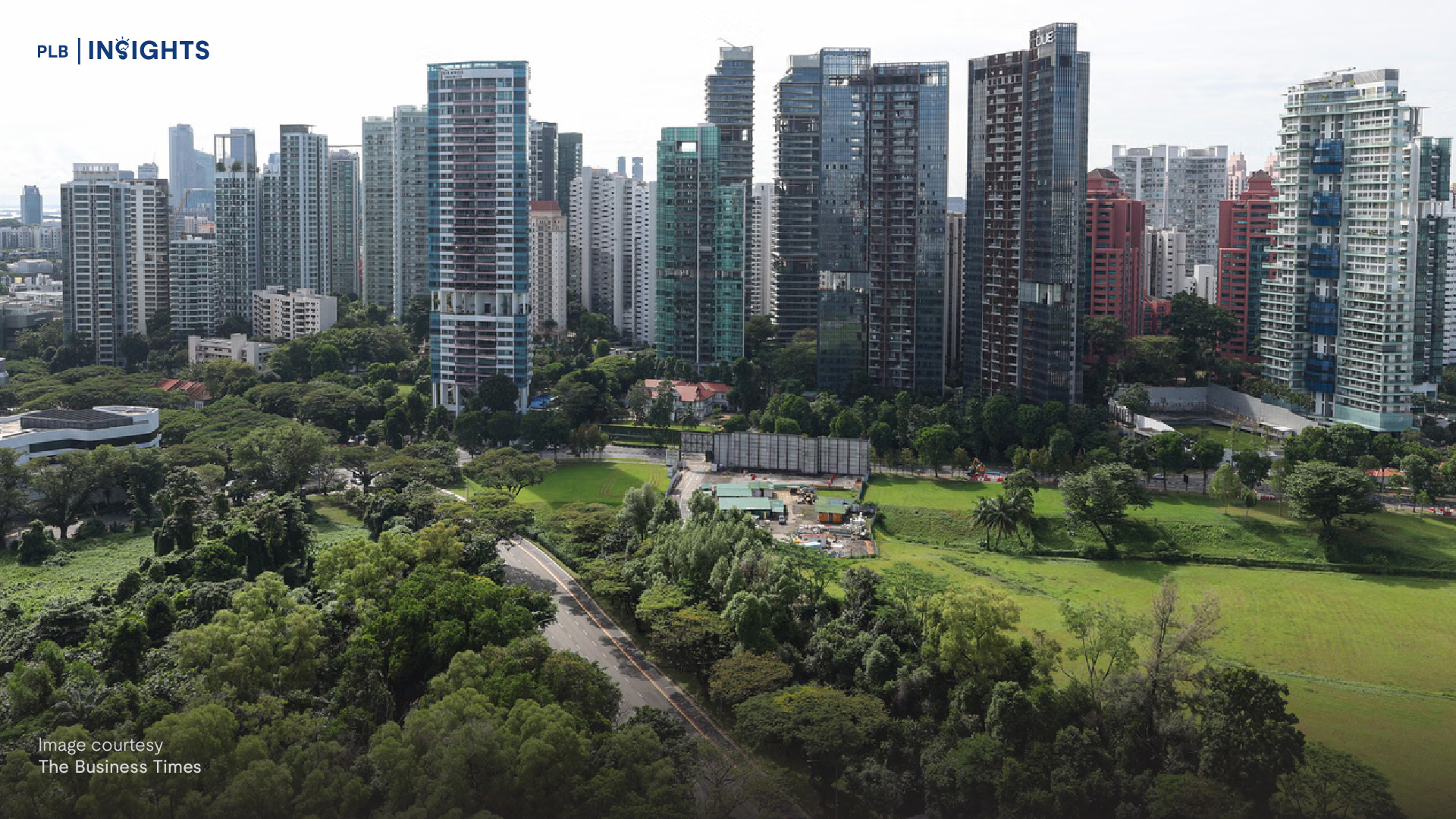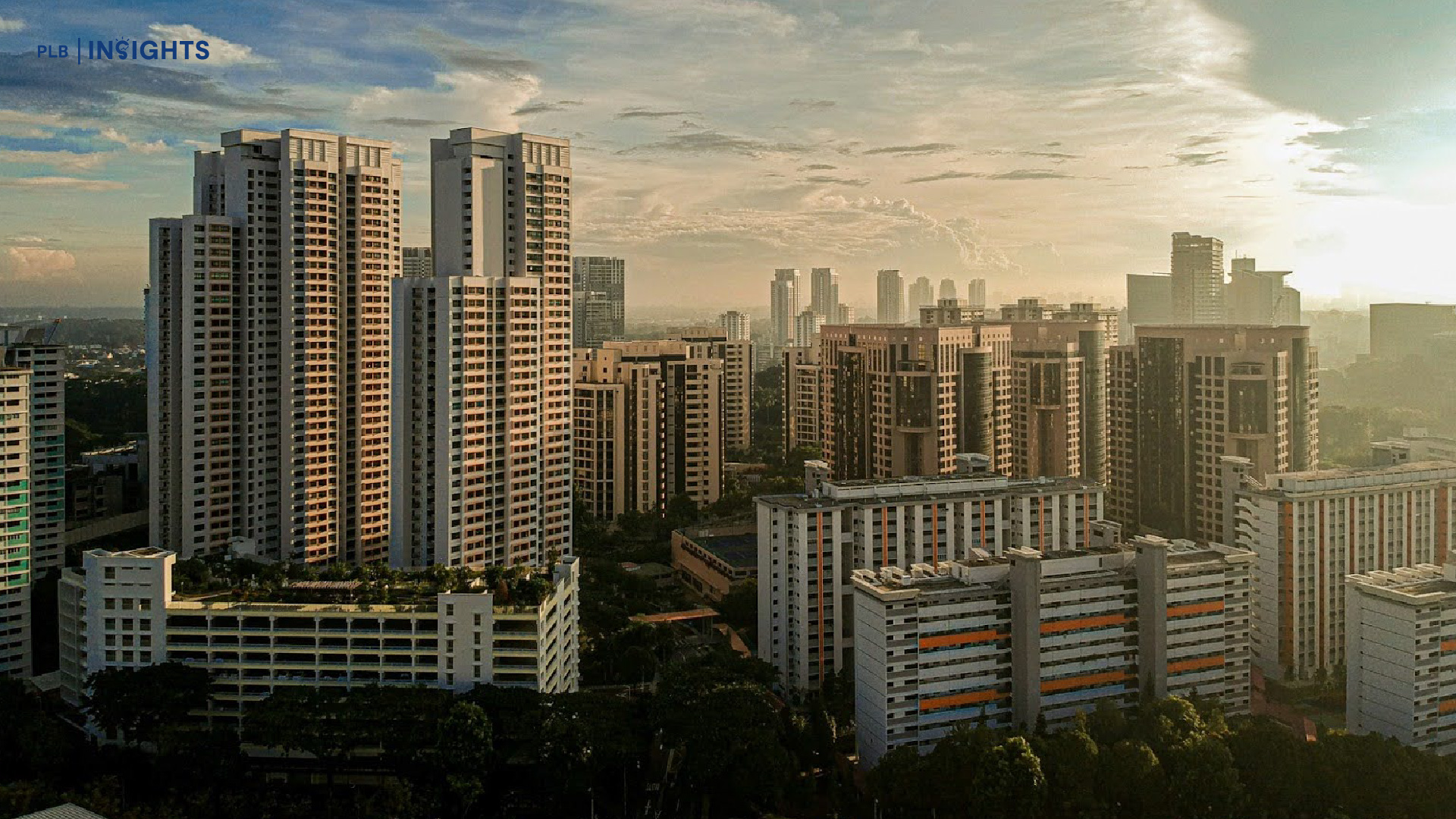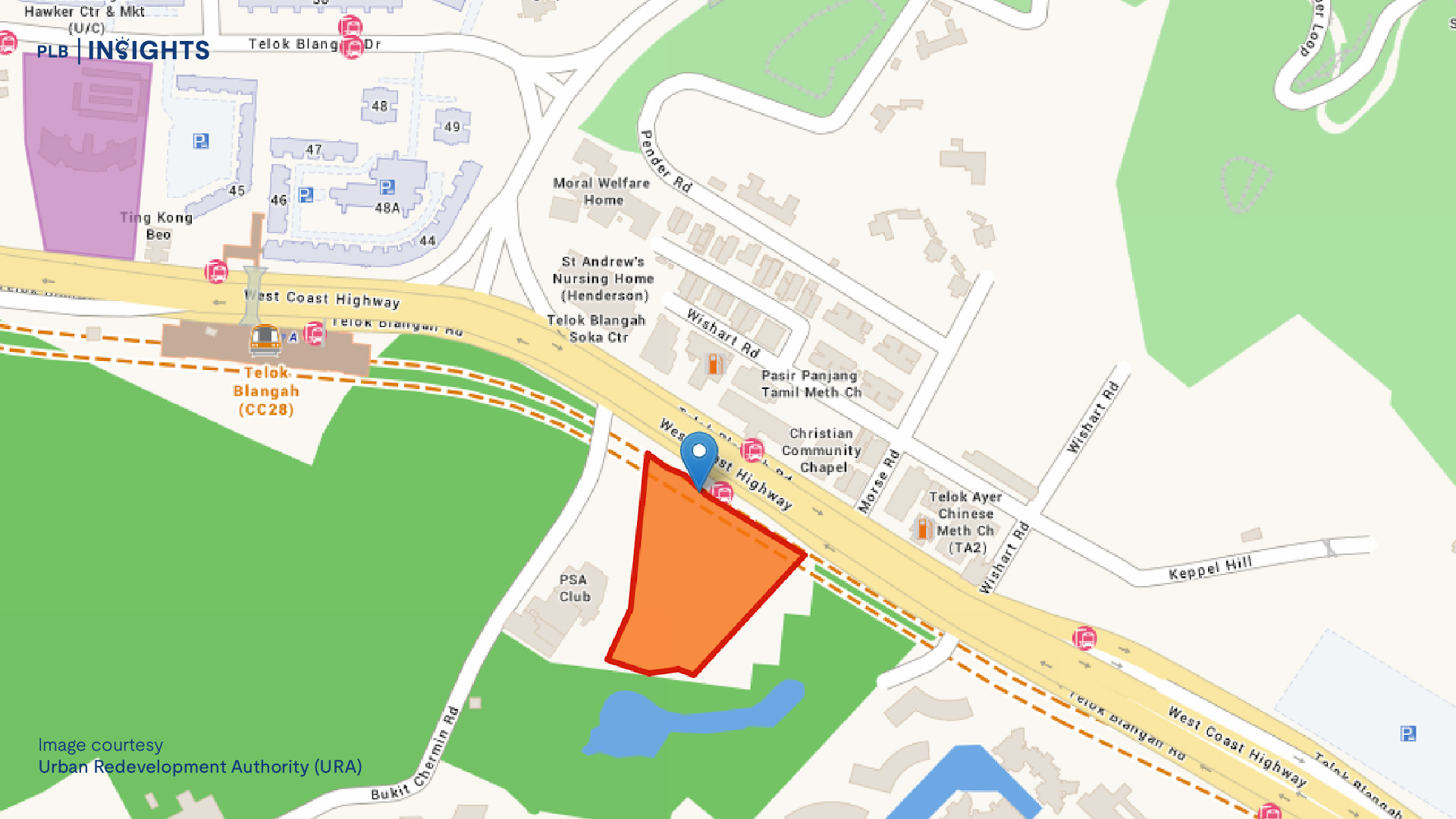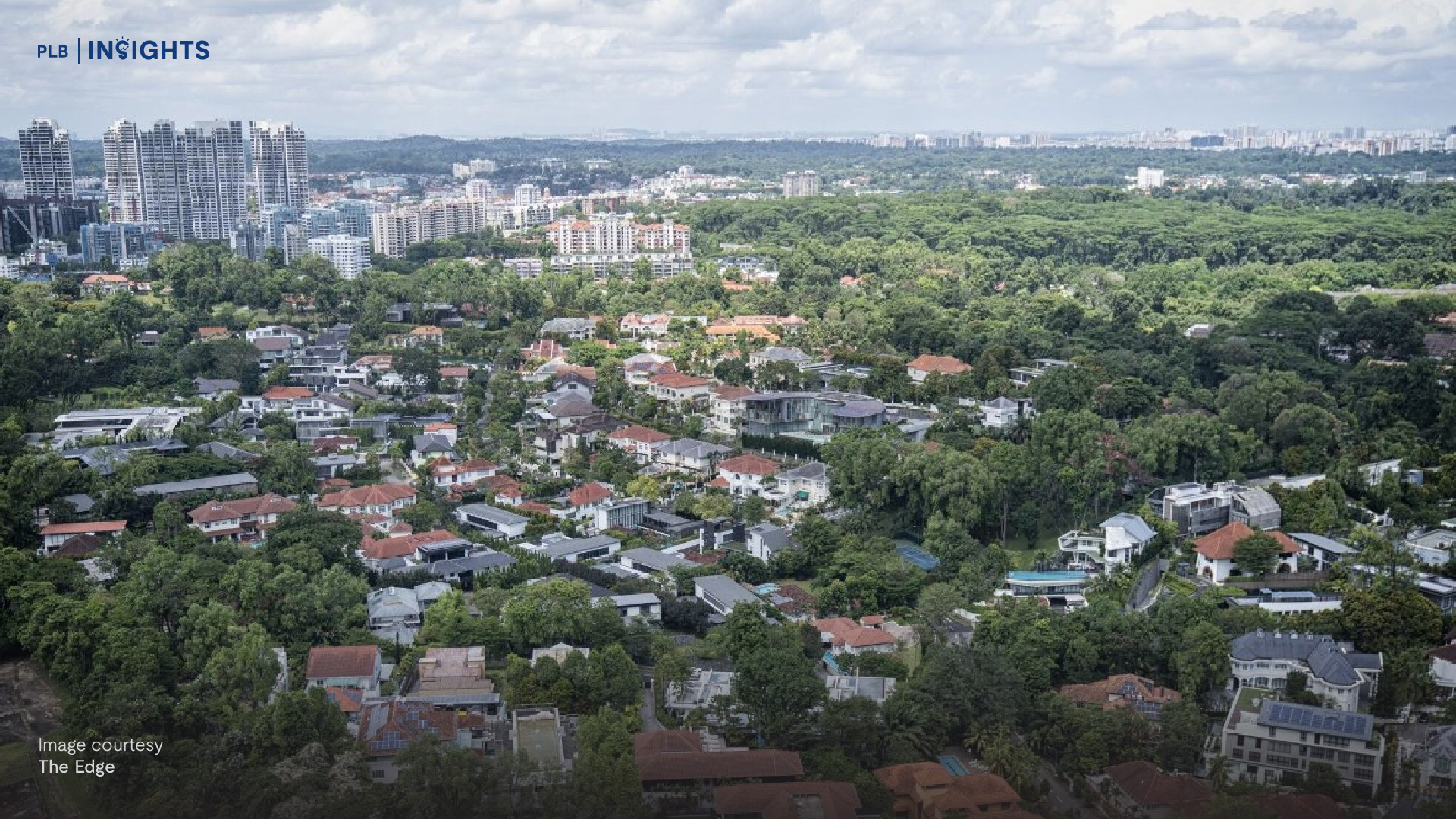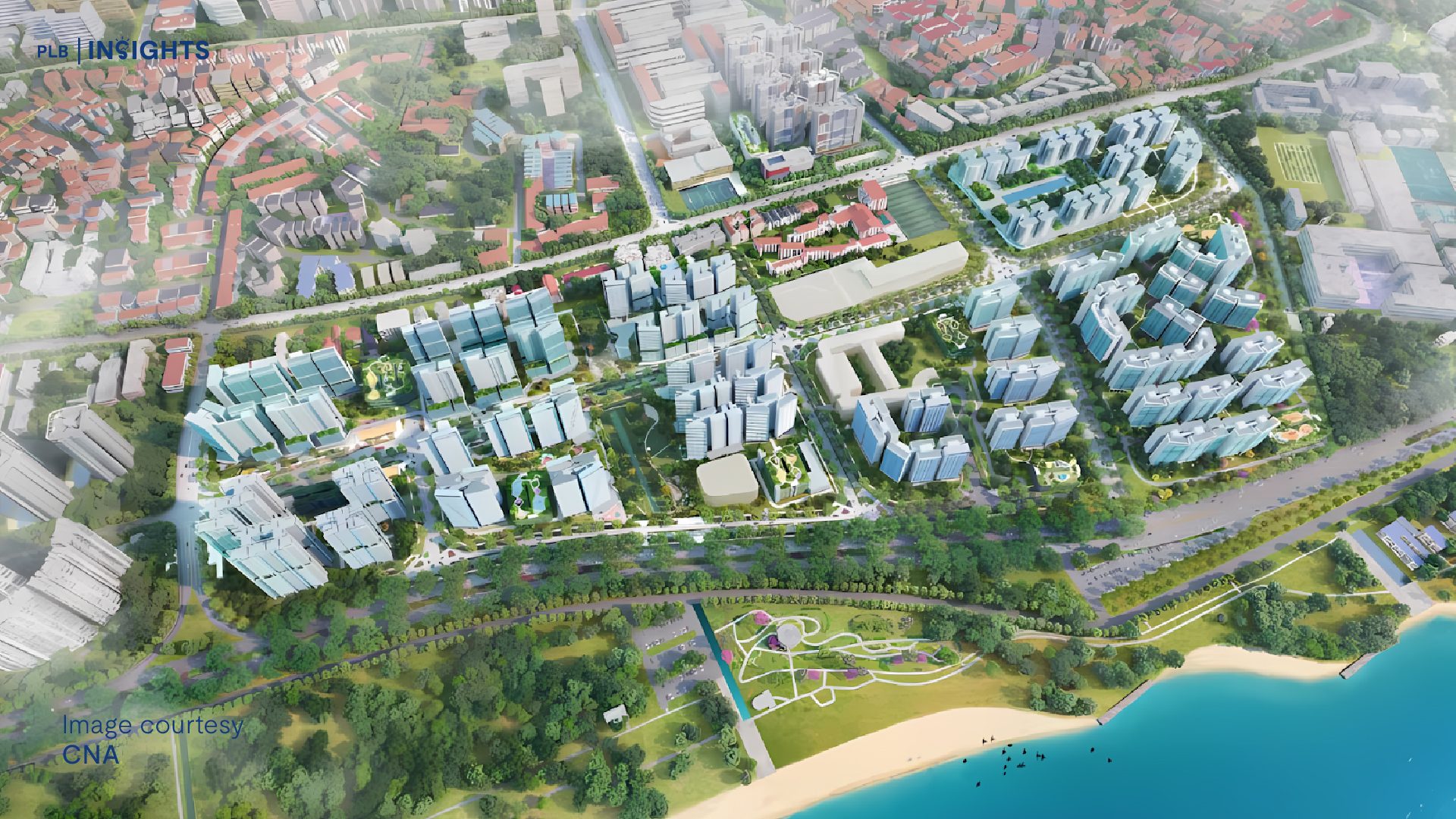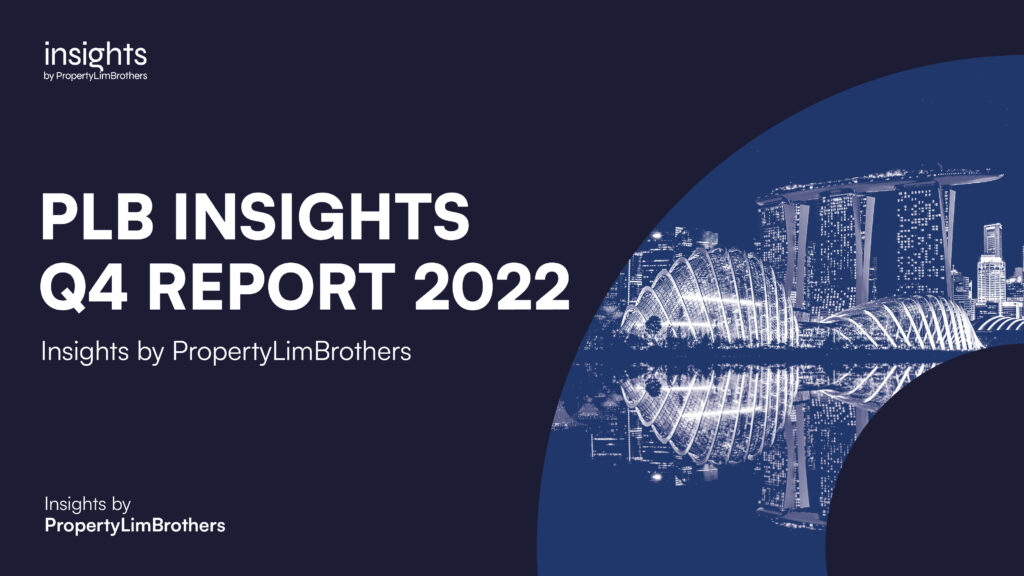
Executive Summary
Inflation remains one of the top concerns of Singaporeans. In particular, the high cost of living has been driven in part by higher rental and property prices. Singaporeans polled by YouGov indicated that housing affordability and cost of living need to be dealt with better. The narratives surrounding inflation are split between inflation peaking and it being sticky. A moderate possibility of sticky inflation remains, with evidence from rising wages, costs of goods and services. The affordability narrative will continue to drive the resale real estate segments in 2023.
Interest rates remain high, with the US Fed currently committing to its rate hikes and showing no signs of a dovish Fed pivot yet. The market is again split between the possibility of a surprise rate cut in the middle of 2023 in response to negative economic data and the possibility of a continuation of the high interest rate environment into 2024. In the former scenario, real estate prices are likely to continue climbing. Whereas the latter scenario might suggest a further reduction in transaction volume and a possibility of lower prices should the high interest rate environment push mortgage rates beyond 5%.
Residential properties will have varied performance across the different segments. We expect HDB prices to remain relatively stable with cooling measures countering inflationary pressures, disparity gaps between the resale and new sale condos to narrow, lower quantum properties to rise in value, and landed properties to display fewer and slower transactions. Overall, the market is suggesting a shift of attention to affordable resale properties in the Outside Central Region.
Commercial properties are on the upward trend after consolidation over the post-pandemic recovery. While macroeconomic headwinds are still present, commercial properties have experienced an increase in rental income and value. Central commercial properties look to lead the recovery for this real estate segment.
Quarter 4 of 2022 has shown us that prices are consolidating as the real estate market in Singapore makes sense of the economic situation and new cooling measures at hand. Property prices remain elevated while overall volume has slumped. The current supply-side fundamentals of the real estate market are still pointing towards elevated price levels and more potential upside upon a Fed pivot.
Foreword by Melvin Lim
CEO, Co-founder PropertyLimBrothers (PLB)
2022 has been a tough year for the real estate market. With overall transactions of residential units falling by almost a quarter from the previous year, most market participants are pessimistic about growth and appreciation potential. When it comes to selling homes in a slowing market, homeowners are faced with longer listing times and the pain point of ineffective marketing. As Singapore’s real estate market gradually transits from a seller’s market to a potential buyer’s market, homeowners and homebuyers alike would need to rethink their negotiating strategies at the table.
Even as property prices continue to climb the wall of worry in 2023, there are still reasons to be cautiously optimistic about the direction of where the market is headed. Buyers and sellers alike need to stay ahead of the curve by keeping themselves updated with the latest developments in the finance and real estate sectors. We hope to be a part of your real estate education through our initiatives in PLB Insights, and our upcoming Webinars and Seminars.
At PropertyLimBrothers,
Real Estate Will Always Be Experienced With Integrity
PLB’s Strategy for 2023 stays true to the heart of what we have been doing since inception. We breathe life into every property by bringing out the full potential of the homes we are selling, and to bring it to its next owner through creative marketing. We want to guide home buyers through every step of their journey, to leave no stones unturned and find every possible gem at each stage of the buying process. PLB is guided by data, experience, and creativity to bring joy to the property journey of our clients.
While the market is split with many opinions on where real estate prices are going in 2023, we have a clear understanding and vision of how we will continue to add value to our fans, followers and clients. We promise you the best-in-class service and education with PLB, and we would love to see you thrive confidently through 2023 and into the future.
Methodology
This report is based on caveat lodged data provided by URA. We supplement this main source of data with other data providers, such as Squarefoot, Edgeprop, TradingEconomics and Statista. Other third party sources also include corporate reports published by reputable banks and top consulting firms. We also make use of economic data provided by various government websites from Singapore and the United States, including information from Central Banks around the world.
Our report pays attention to key macroeconomic trends in the world. We look at how changing monetary policy and growth outlooks might affect the real estate market in Singapore. Close attention is given to Singapore’s demand and supply factors in the property market. Using both macro and micro conditions to inform our analysis, we share with you our take on how the real estate market will perform in the coming quarters.
Micro analysis is mainly centred upon price and volume movements in the market. We use a non-parametric subsampling approach to find discrepancies between the performance of different segments in the real estate market. We take performance data from URA and proceed with creating subsamples for analysis. The samples are sliced by property type, size, location, and other characteristics. The mode of analysis is mainly descriptive. With some qualitative analysis and comments on consumer sentiment and behaviour.
This Q4 report follows through with the previous two reports on how ongoing macroeconomic tensions in the form of high inflation and high interest rates will continue to affect Singapore’s real estate market moving forward into 2023.
Contents
Macro
- The Case for Sticky Inflation in Singapore
- Interest Rate Direction and Potential Effects on Real Estate
- Supply-Side Concerns for Residential Real Estate
- Overall Macro Situation
Micro
- Resale HDB Prices & Volume to Remain Resilient
- Executive Condominiums To Attract More Buyer Attention
- Private Non-Landed Properties Consolidating Pandemic Gains
- Landed Properties Inch Higher Despite Slowdown
- In Focus — Opportunity Spaces for 2023Q1 and Beyond
The Case for Sticky Inflation in Singapore
As 2022 concludes with some encouraging Q4 data on inflation, it is still insufficient to abate concerns of sticky inflation. The All-Items inflation rate has fallen from the high of 7.5% to 6.5% in December 2022. While many market commentators are speculating that September 2022 marked the peak of inflation rate, it remains a question whether the inflation rate will fall back to the healthy rate of around 2% anytime soon.
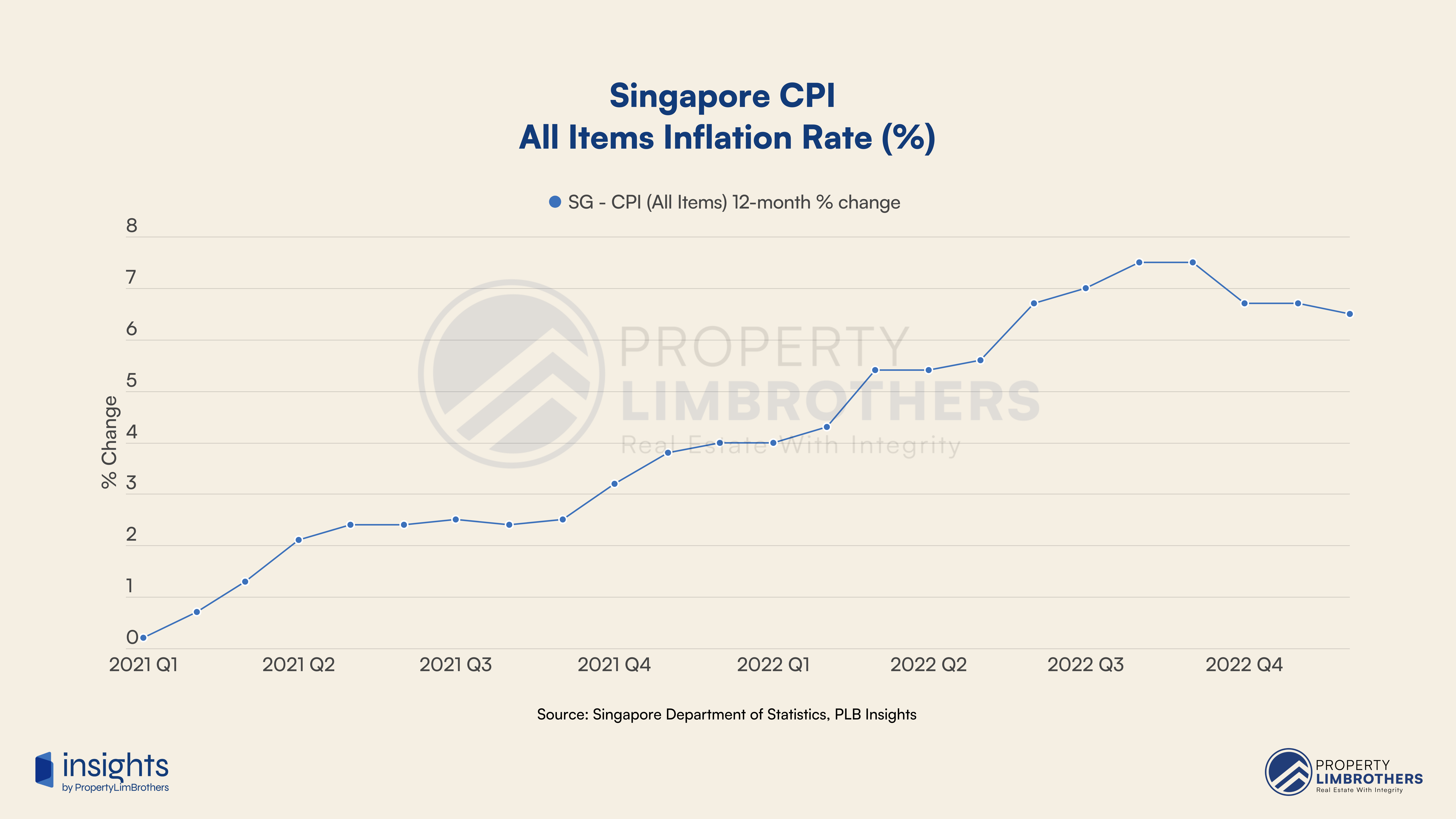
As the economy is factoring in higher cost of goods, services, and labour (including taxes), it takes time before such increases in costs are reflected in business decisions to raise prices. What we get is an upwards spiral of prices based on the cost-push inflation in the economy. There is mounting evidence of businesses and organisations taking the view of entrenched inflation (or sticky inflation); transitory inflation is a myth of the pandemic years.
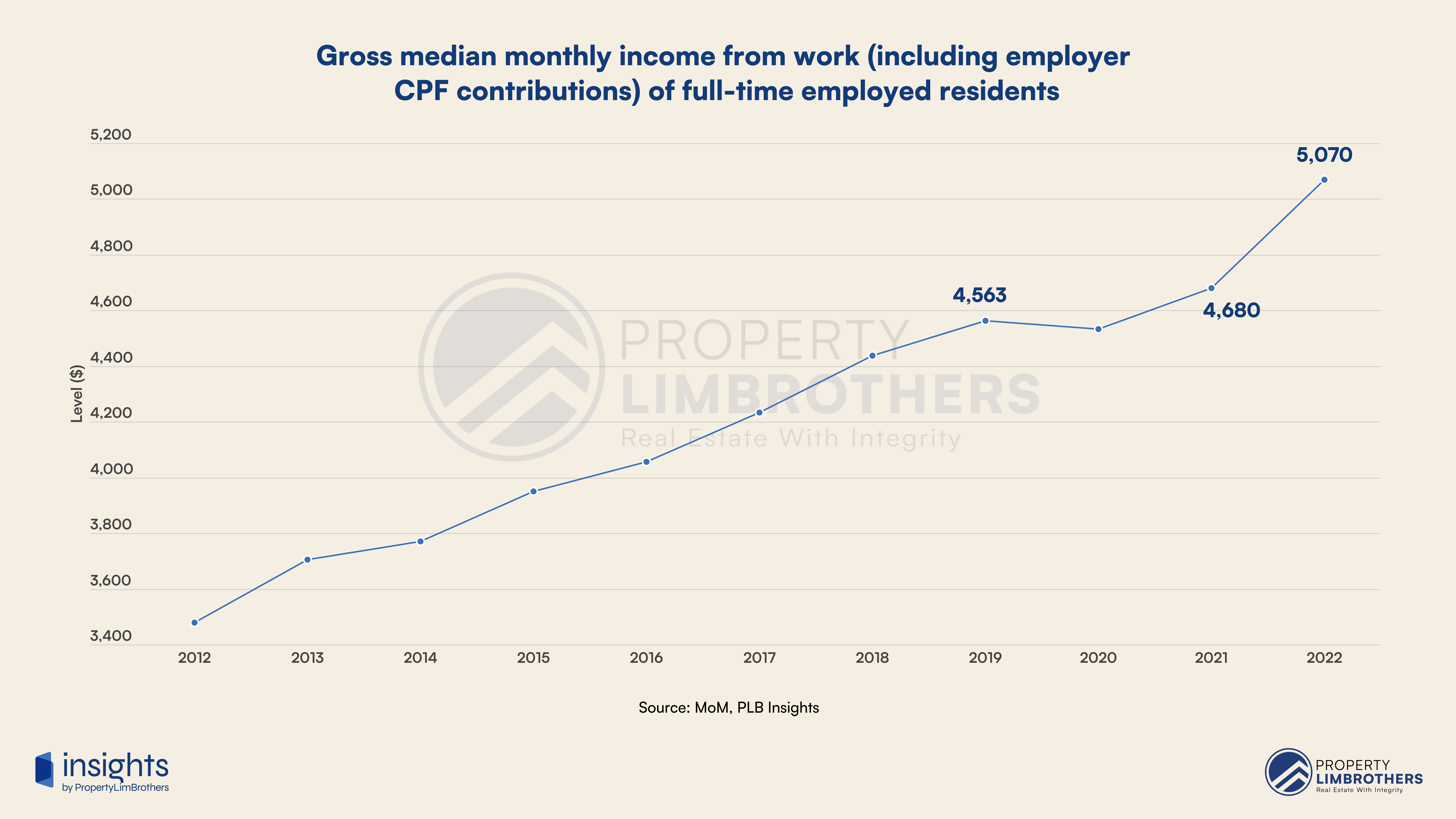
This upwards pressure on prices is gaining traction with median gross monthly income increasing by 8.3% in 2022 as opposed to 3.2% in 2021. Government agencies are also pushing for higher wages for the lower income groups, the government budget also co-funds these higher wages. Fresh rounds of wage increases have not been priced into the market through the All-Items inflation and will take time to reflect in the form of higher prices of goods and services over the course of 2023 and 2024. This strengthens the case for sticky inflation.
The URA Q4 data release highlights much higher private property prices and rentals, which are reflective of the larger inflationary trends. We see an overall increase in price by 0.4% and increase in rentals by 7.4% on their respective indices. This is in contrast to the higher growth numbers in 2022Q3, which saw an increase in price by 3.8% and increase in rentals by 8.6%. This is preliminary evidence of the deceleration in the real estate market. Do note that despite this deceleration in higher prices and rentals, there is still a net increase.
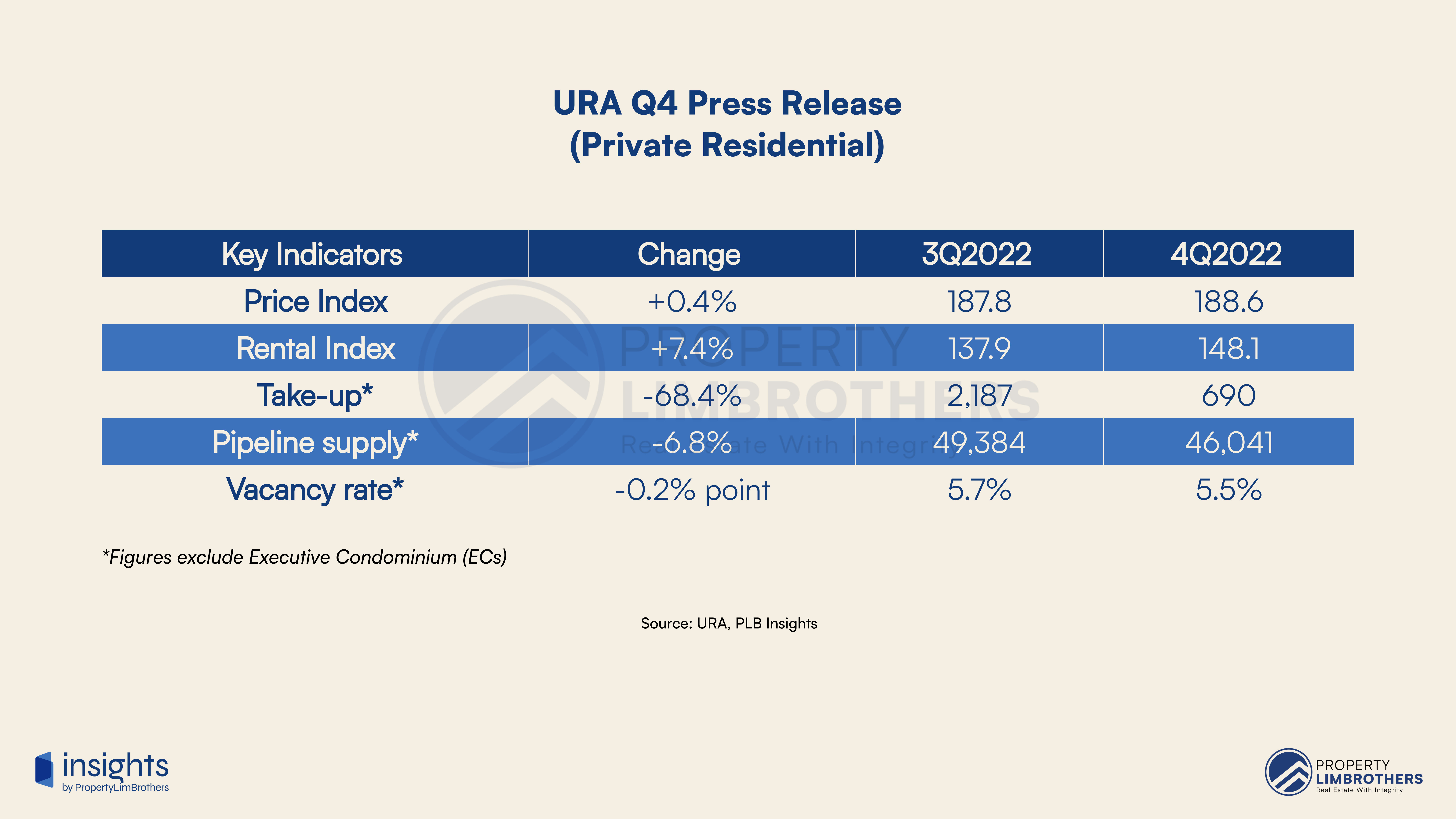
It is important to note the declining quantity demanded at these higher prices based on the lower take-up rate (-68.4%). However, we started to notice decreased pipeline supply (-6.8%) and vacancy rates (-0.2%). These are signs that some buyers are priced out of the market but there exists a strong supply-side issue that is not addressed. Overall, there are hints that recent market movements are driven more by supply-side dynamics than demand-side mechanics.
Interest Rate Direction and Potential Effects on Real Estate
The Monetary Authority of Singapore (MAS) is expected to continue with hawkish monetary tightening policy. This is in line with most central banks in the world, particularly the US Fed, which has made another recent interest rate hike of 25 basis points on 1 Feb 2023. The current fed funds rate is between 4.5% and 4.75%, this number is expected to peak in 2023 at 5% to 5.25% with a few more interest rate hikes. Singapore’s overnight rate (SORA) sees a one-percentage point lag from the US interest rates, it is currently sitting around 3.56%. Interest rates in Singapore are expected to rise further in 2023.
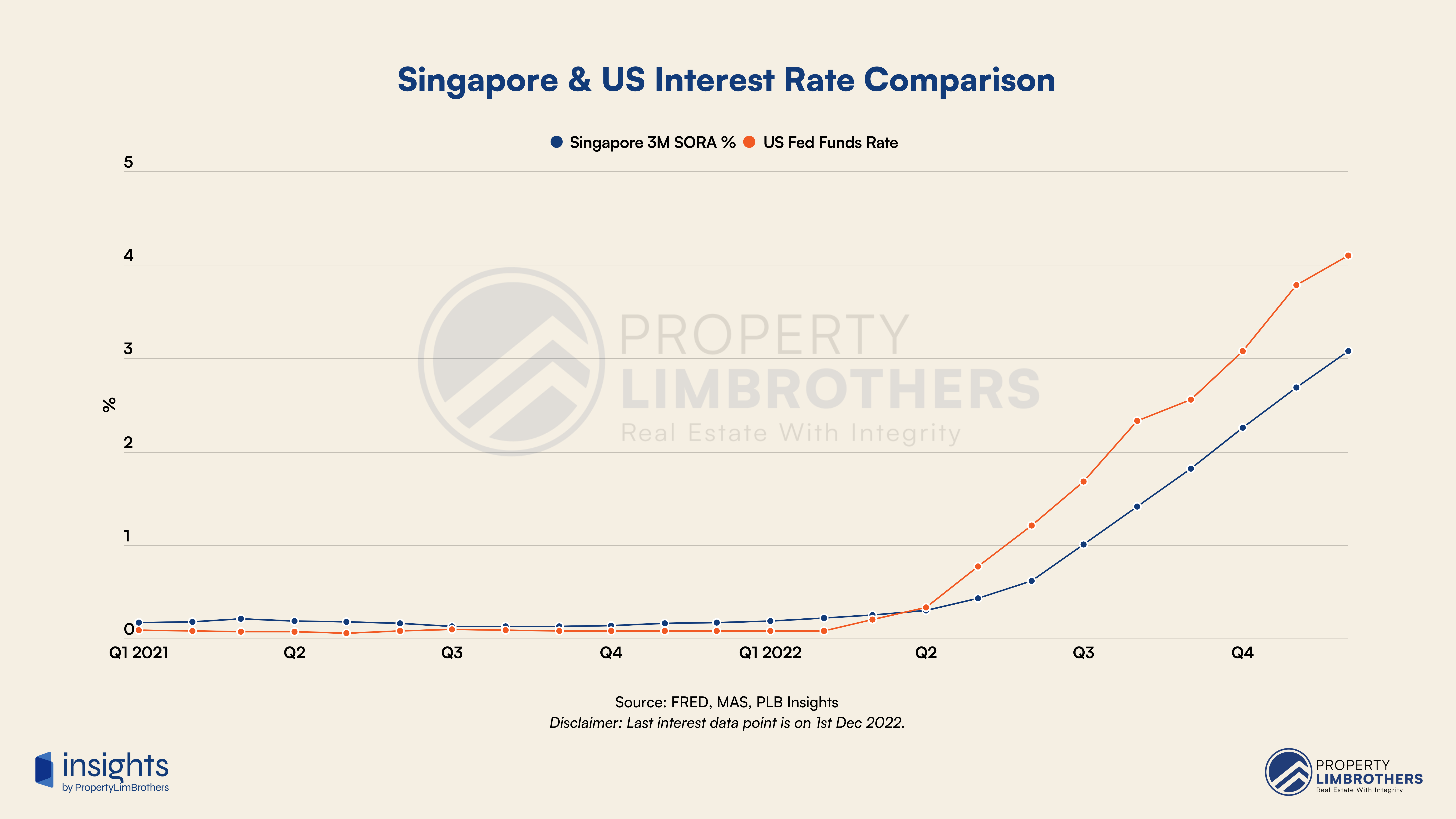
With a much stronger chance of sticky and high inflation, the market is expecting a year of high interest rates still. While this has been one of the fastest interest rate hiking cycles in history, the job is far from over. Until inflation numbers hit the 2% benchmark targeted by central banks, it is likely that home buyers will continue to feel the impact of rising interest rates. Given that interest rates are expected to peak in 2023, home buyers securing new loans could consider floating rate mortgages to hedge against the risk of a surprise early rate cut and take the central banks’ word on their plans.
In the previous quarters, Interest rates were thought to peak at around 4.5% to 4.75% in the US Market. This terminal rate has since risen to the 5% to 5.25% range, suggesting that there will be more interest rate hikes in 2023 totalling 50 basis points. Thus far, the terminal rate has been increasing beyond past expectations based on inflation numbers.
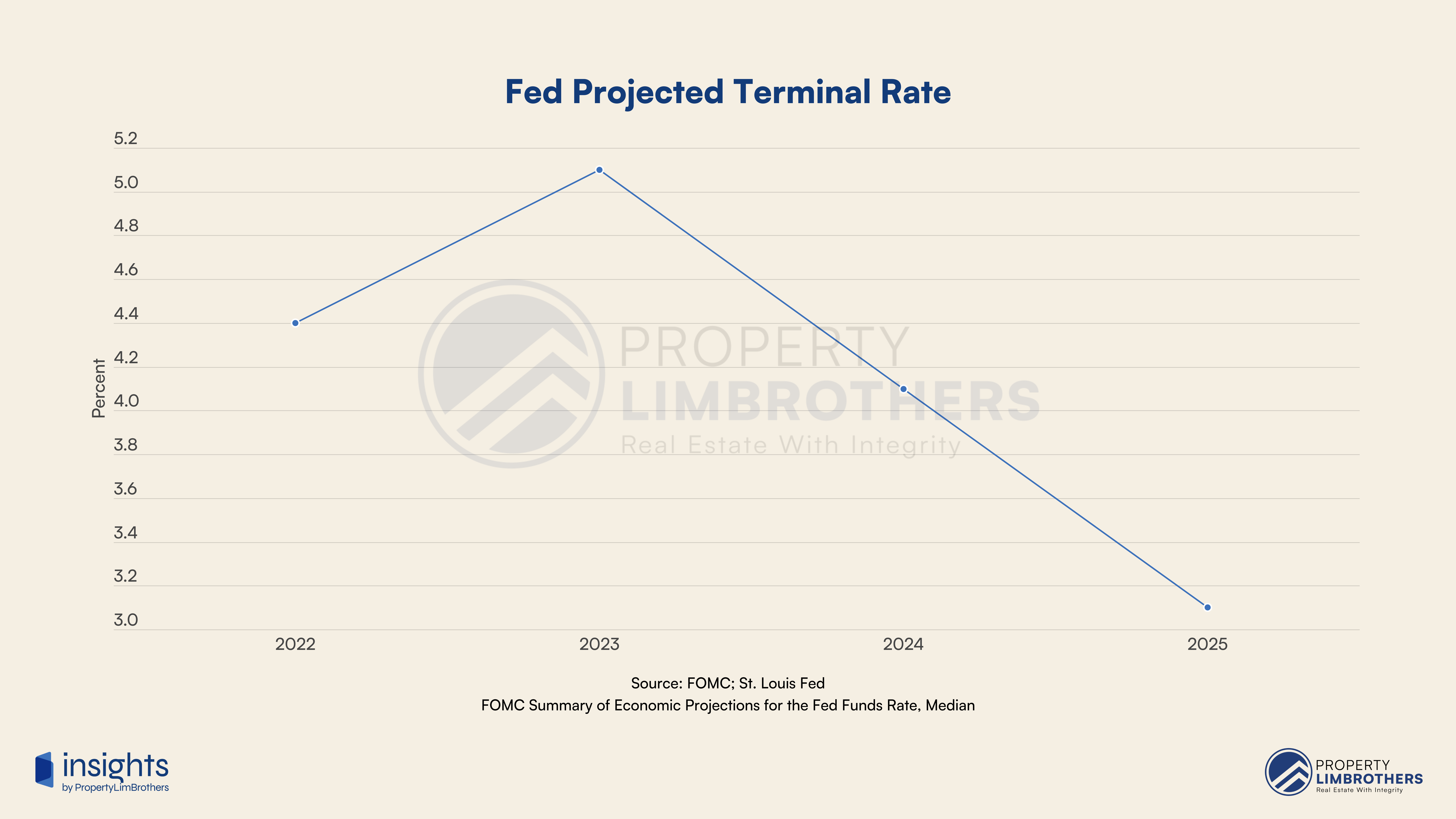
A Fed pivot is currently not on the table. Some optimists speculate that a surprise pivot is possible given bad economic data for 2023 Q1 and Q2. Until the data has printed negative GDP numbers then, a pivot seems unlikely. Rather, sticky inflation has seen an increase in the terminal interest rate in the US. It is more plausible that further surprise hikes are on the horizon should inflation rates remain persistently high.
As a result of this high interest rate environment, mortgage rates in Singapore have been elevated. With the 3-month SORA hovering around 3.14%, we see floating mortgage rates (for private properties) hit around 3.7% to 4.1% and fixed mortgage rates going from 3.75% to 4.25%. With another 50 basis points worth of hikes projected in 2023, we might see mortgage rates go as high as 4.75%. Any further increase in the terminal interest rate from here could have negative effects on the price of real estate as mortgage rates go beyond an affordable level of around 5%.
The interest rate conditions coupled with sticky inflation are counteracting forces on the price of real estate. With the inflationary forces winning out, we still see the price of real estate and rentals increase in 2022 Q4. Should any surprise rate cuts come into the picture in 2023, we could see a further upward trend in prices. Whereas further rate hikes that push the current terminal rate beyond 6% will see Singaporean mortgage rates go to an unsustainable level, putting a downward pressure on home prices.
Supply-Side Concerns for Residential Real Estate
With the closure of 2022, we see an approximate decrease of 33% in the volume of transactions for private residential properties but an increase in average psf of 7.3% from 2021 to 2022. Although the volume of transactions is above the pre-pandemic levels, we are observing a dip in transactions and expect volume to decrease through 2023 to get closer to pre-pandemic norms. This could translate into longer selling durations as it is harder to find an appropriate buyer at elevated prices.

In the Resale HDB Segment, average psf increased by 9.8% from 2021 to 2022 while transaction volume decreased by 6.5%. Compared to the private residential segment, there is a higher increase in average price but transaction volume did not decline as rapidly. The volume trend for the Resale HDB segment has also been steadily increasing over the past 8 years, with the exception of a spike in volume in 2021. We expect this trend to continue despite the rough economic conditions in 2023. Prices are expected to stabilise at elevated levels.
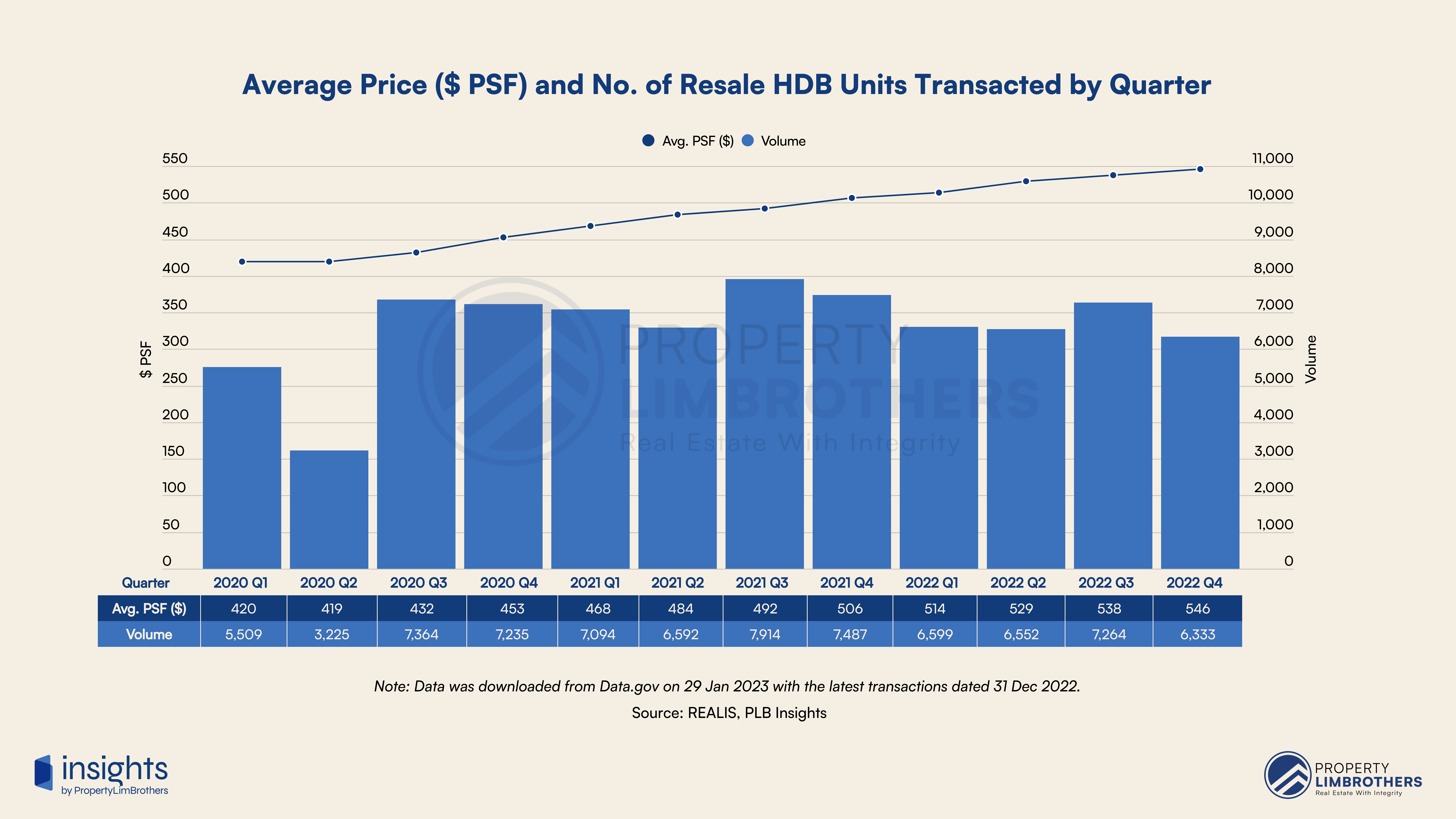
The disproportionately larger decrease in volume of transactions coupled with the increase of average psf in 2022 indicates that a supply-side issue is burgeoning in the private residential segment. We see some potential effects of spillover demand into the Resale HDB segment as the average price increased disproportionately larger than the fall in transaction volume.
This is an instance where the disparity gap between private-public housing pushes the demand and price of resale HDBs up. However, the 2022 Q3 cooling measures restricted ex-private property owners (ex-PPOs) with a 15-month waiting period before they can purchase a resale HDB. This might curb the effects of spillover demand into 2023.
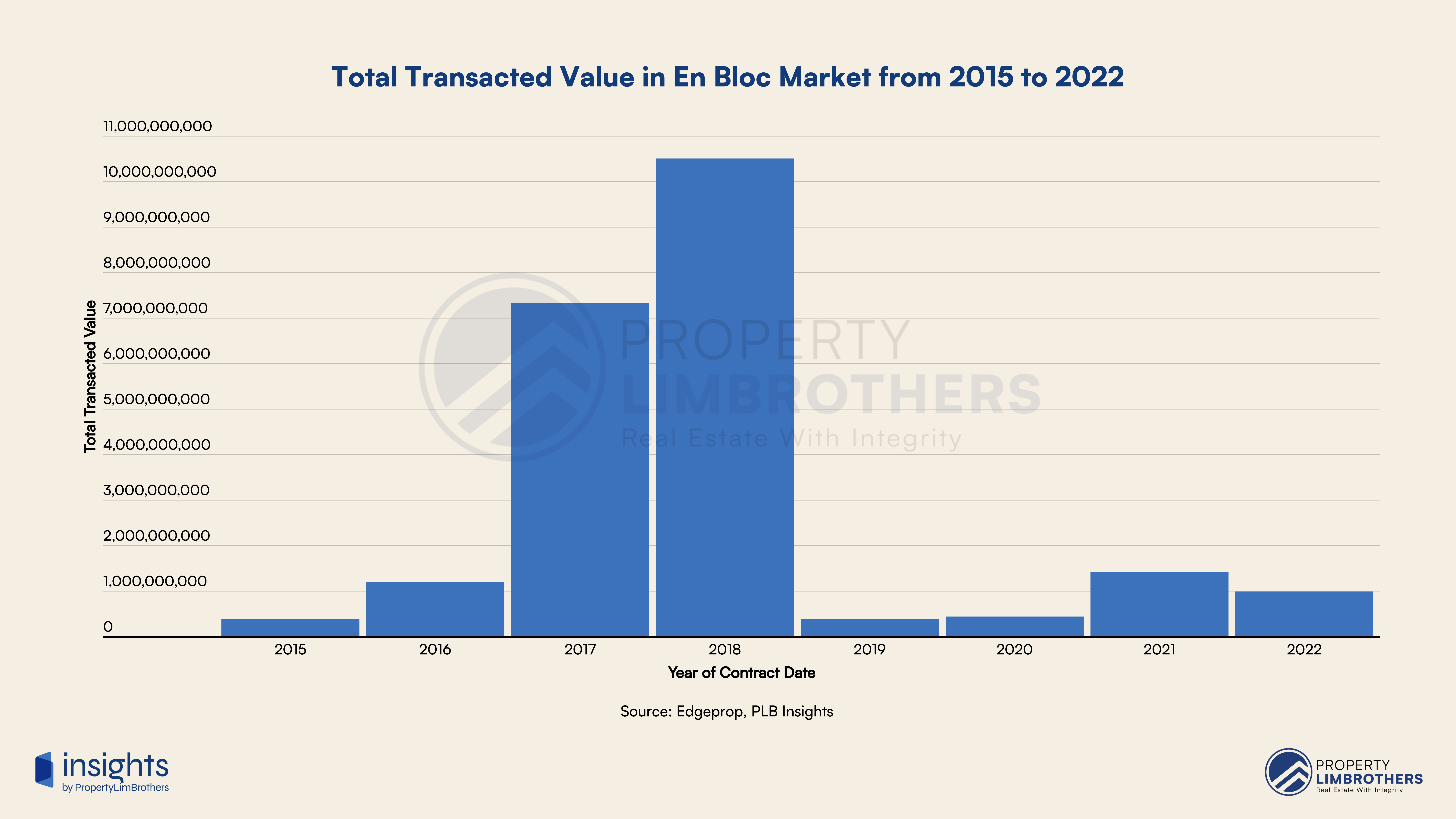
The supply-side concerns reflected in the price and volume movement in the private and public residential segments are also present further up the value chain. Developers refilling their land banks via Government Land Sales or En Blocs have experienced a much tighter supply situation than the previous decade. With bidding mechanics in place to extract the highest possible price from developers, the cost-push inflation in housing is largely driven by this shrinkage in supply further up the value chain.
This can have serious implications in the residential housing market as developers pass costs down to consumers in the form of higher property prices. While prices have not reached an unaffordable level yet, it is possible that this becomes a pressing issue in the coming years if the supply of land for residential purposes remains so constricted.
Due to the length of the property development cycle (around 4 years), the supply-side concerns are likely to remain for the foreseeable future. This translates to a strong upwards pressure on prices for residential real estate in Singapore. Despite tough macroeconomic conditions, the demand-supply mechanics remain a first-order effect on the price and volume outcomes for residential properties. Even with a decline in volume, prices are expected to rise or remain high with the tight supply situation.
Overall Macro Situation
The Macro Situation for Singaporean Real Estate is still relatively stable compared to other developed property markets, such as the ones in the United States and China. The effects of high interest rates have not reached a degree where mortgages are unaffordable and demand plummets. Rather, a consistently tight supply across different real estate segments has kept prices elevated despite a fall in transaction volume.
We might see limited spillover demand effects from the private to public real estate segments as the 2022 Q3 cooling measures prevent some private property owners (PPOs) from purchasing resale HDB properties immediately after disposing of their private properties. The 15-month waiting period is sufficiently long to taper such spillover demand from disparity gaps, subsequently stabilising resale HDB prices and potentially diverting the demand to OCR Resale Condominiums and Apartments instead.
Inflation and interest rates are expected to remain high throughout 2023. However, any surprise interest rate cuts will have a strong bullish impact on the property markets and improve investor sentiment in the real estate market. Despite the high interest rate environment and potential recession, property prices are expected to remain elevated as supply-side concerns are likely to persist.
Resale HDB Prices & Volume to Remain Resilient
The Resale HDB segment is one that is closely watched by regulators and market participants alike. As it forms the backbone of the property market, with the majority of Singaporean households living in HDB flats, the Resale HDB segment impacts the household wealth of Singaporeans to a great extent. 2022Q4 experienced the lowest transaction volume over the past 10 quarters, with a total of 6,333 transactions. In addition, prices have made a recent high of $546 psf.

The price levels are expected to stabilise as cooling measures now restrict PPOs from purchasing resale HDB flats for 15-months upon the disposal of their private property. Demand for Resale HDBs is expected to cool, with transaction volume falling back to pre-pandemic levels. With many BTOs experiencing delays in construction, the short-term supply for Resale HDB flats is expected to remain relatively tight in the coming years.
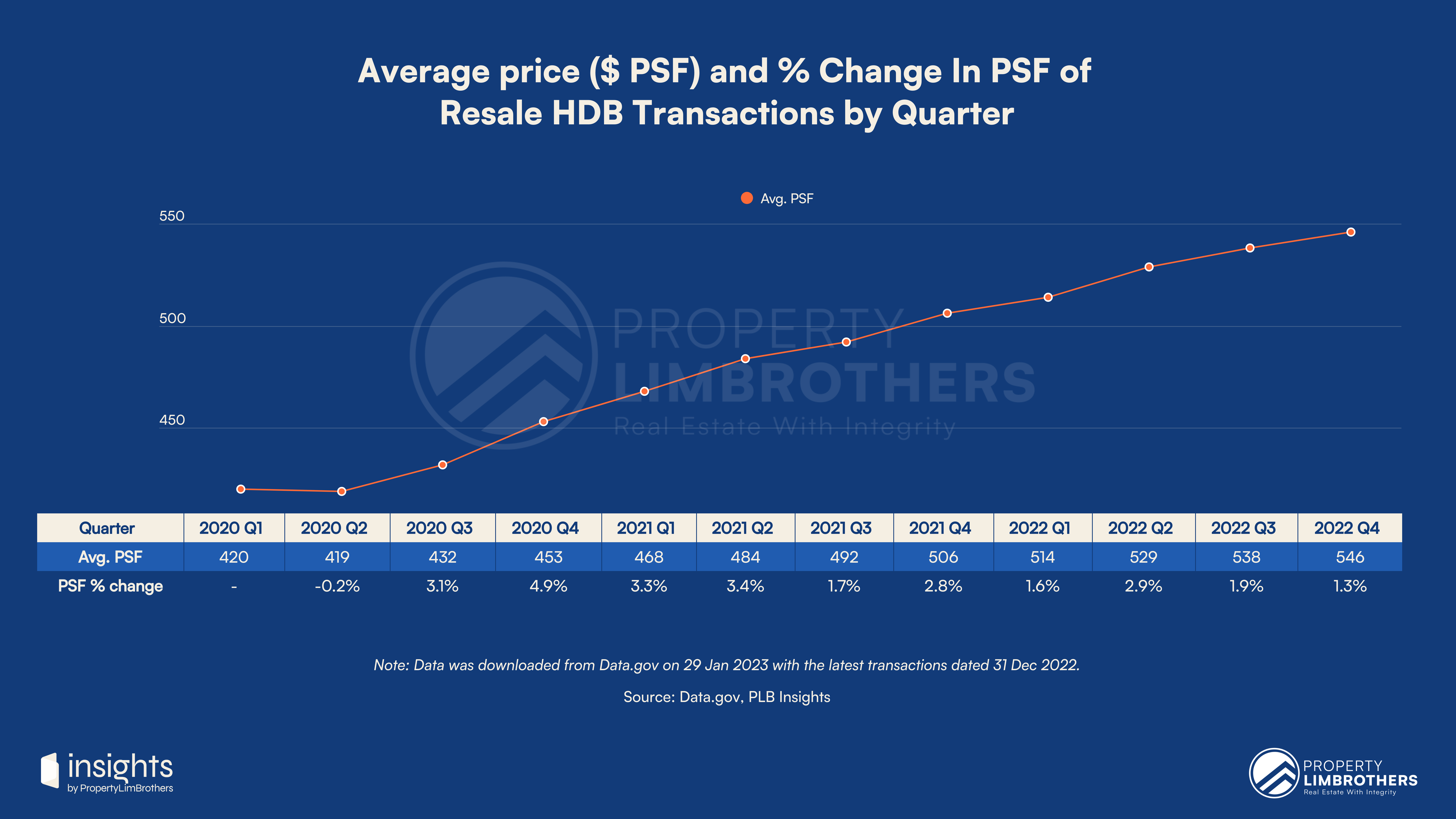
Average price for Resale HDBs rose from $538 to $546 psf, a modest increase of 1.5%. The volume of transactions increased from 7,264 to 6,333 transactions, a 12.8% decrease from the previous quarter. This market movement is in line with our previous forecasts. For the coming quarters, we expect prices to start stabilising, with decelerating growth. Transaction volume is expected to decline further to reach pre-pandemic levels.

The price performance of Resale HDB flats continues to vary by geography. Districts 1 (Central Area), 14 (Geylang), and 20 (Bishan), which previously saw a decline in psf prices are now experiencing a rebound in prices. District 1 has the highest psf growth in 2022Q4, likely due to the size of the previous decline, allowing for a strong rebound. District 5 (Clementi) which experienced a decline in the previous quarter continues to decline marginally in Q4. This might point to the market rejecting higher prices of HDB in District 5.

The top 5 performing districts by absolute increase in average psf are 1 (Central Area), 10 (Bukit Timah), 3 (Bukit Merah), 20 (Ang Mo Kio), and 25 (Woodlands). Compared to the previous quarter, we notice that some districts with extraordinary growth revert to mean. If the growth rate was exceptionally high, negative growth in the subsequent period would be more likely the case. The lower performing districts by absolute decrease in average psf are 12 (Toa Payoh), 3 (Queenstown), 14 (Kallang/Whampoa), 5 (Clementi), 19 (Hougang).
As property prices in Singapore continue to inflate, we see volatility start to show in the more expensive locales across Singapore. Outside Central Region (OCR) Resale HDBs have been steadily increasing in terms of the average psf and show the most stability compared to more central districts. We expect this trend to continue, where disparity gaps across and within real estate segments start to tighten and get narrower.
Executive Condominiums To Attract More Buyer Attention
The Executive Condominium (EC) segment is likely to attract more buyer attention in 2023. With Resale ECs as a more affordable option to the existing pool of Resale OCR Condos, we expect to see average psf rise for this category. In addition, we expect the volume of transactions to remain relatively resilient compared to the rest of the private property market.
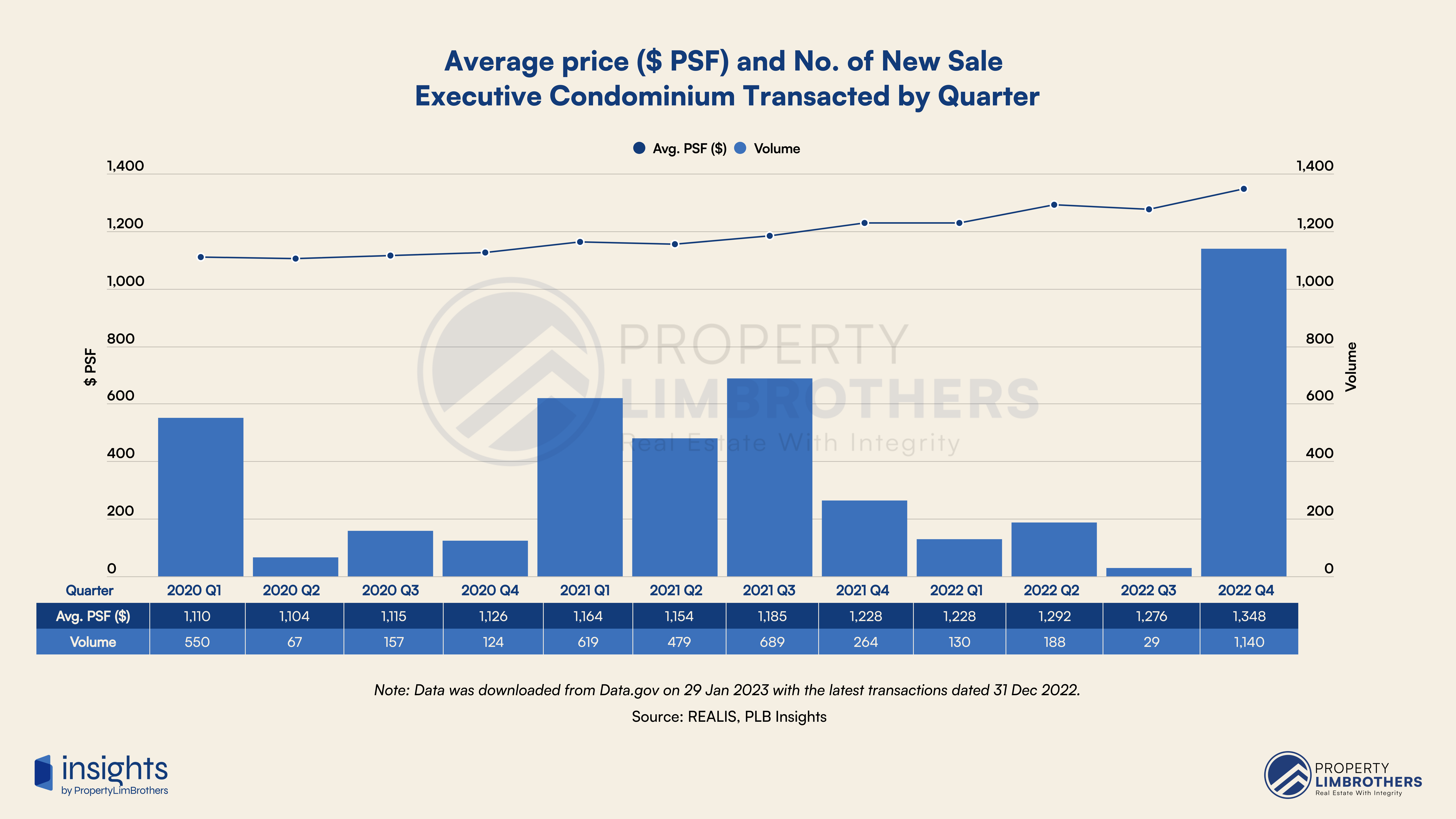
New launch ECs are an affordable form of subsidised housing for Singaporeans. Arguably, the return on investment is better with ECs than HDBs with the prospect of full privatisation 10 years from the TOP date and even upon fulfilling the MOP period. 2022Q4 experienced a surge in transaction volume due to new ECs (Copen Grand & Tenet) that were launched in that period. We pay less attention to the transaction volume of new sale categories due to the volatility caused by the timing of the launch. Average psf for new sale ECs increased from $1,276 psf to $1,348 psf, which represents an increase of 5.6%.
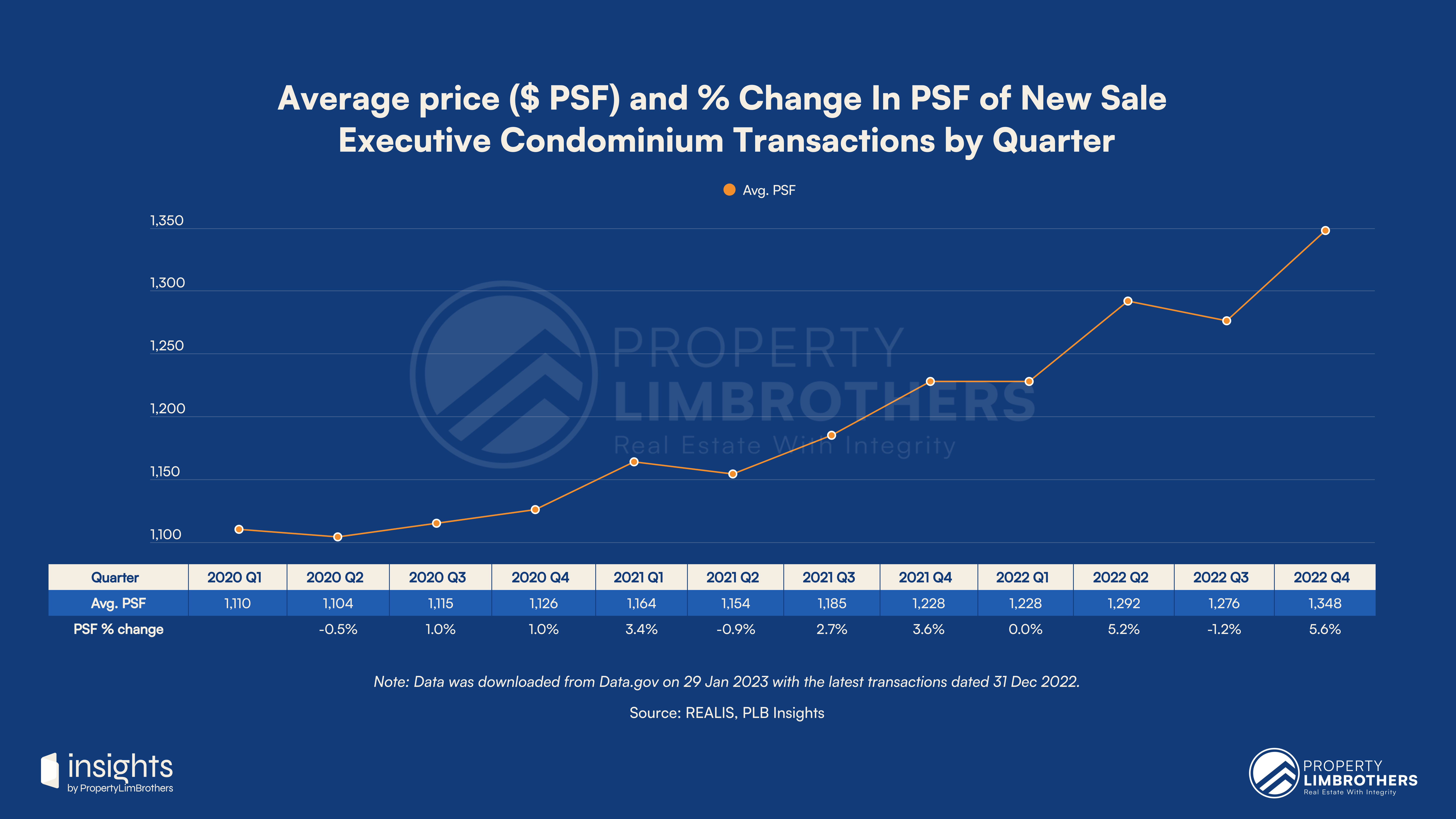
On the other hand, Resale EC transactions have fallen from 556 (2022Q3) to 426 (2022Q4), this is a 23.4% decrease in volume from the previous quarter. While the volume of transactions has dipped significantly, it is still drastically higher than pre-pandemic volumes. We expect the volume of transactions and prices to both stay elevated. In particular, we expect the transaction volume for this segment to stay healthy and above 2020 levels in the coming year.
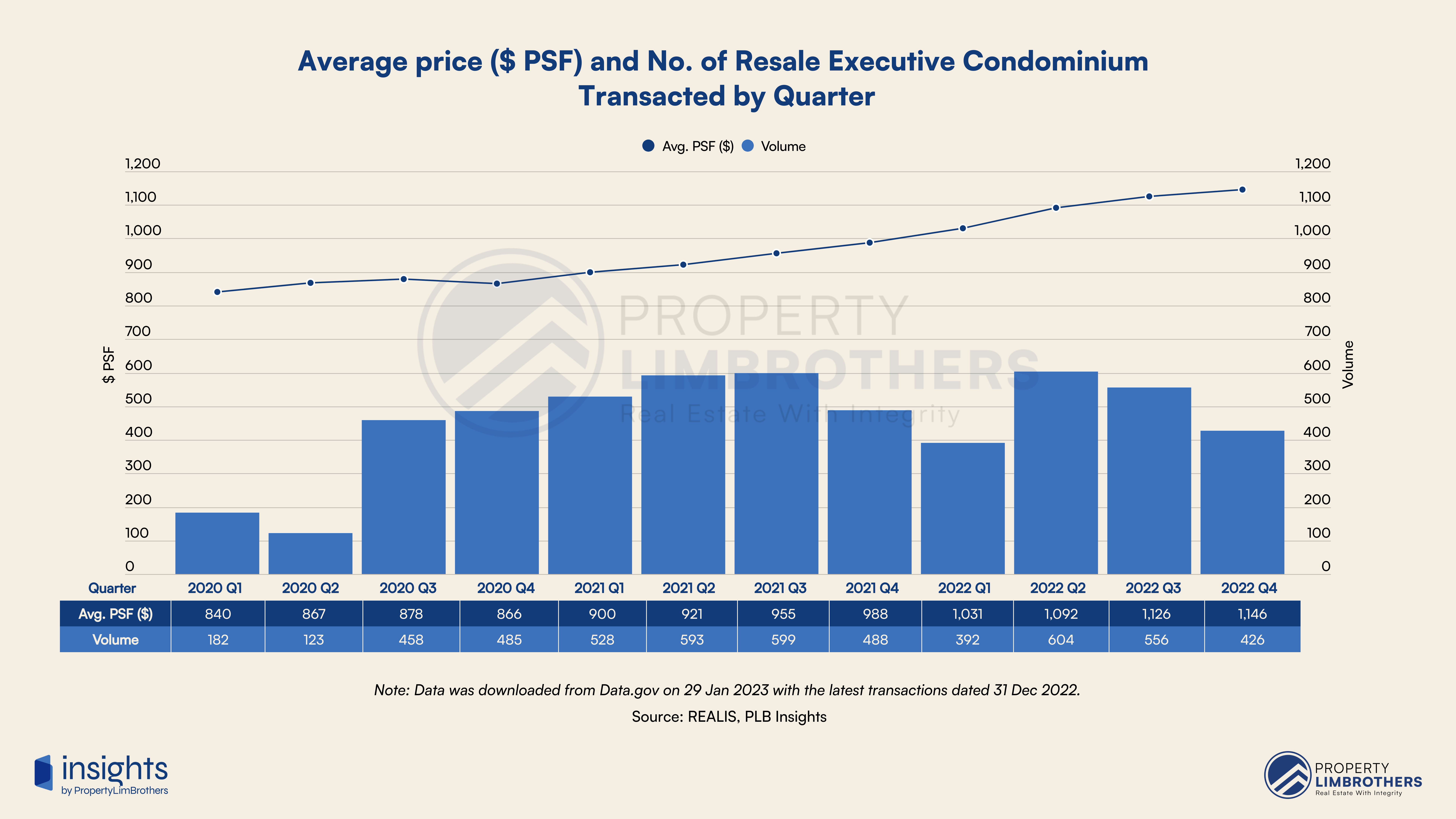
Resale EC prices have experienced a gentle climb of 1.8% in 2022Q4, with prices rising from $1,126 psf to $1,146 psf. The rate of growth for EC prices is decelerating and is expected to stabilise near present levels in the coming quarters. These Resale EC prices are at very attractive levels relative to the rest of the private property market. In the coming quarters, spillover demand might find its way to newly MOP-ed ECs, raising the average psf in that specific subcategory.
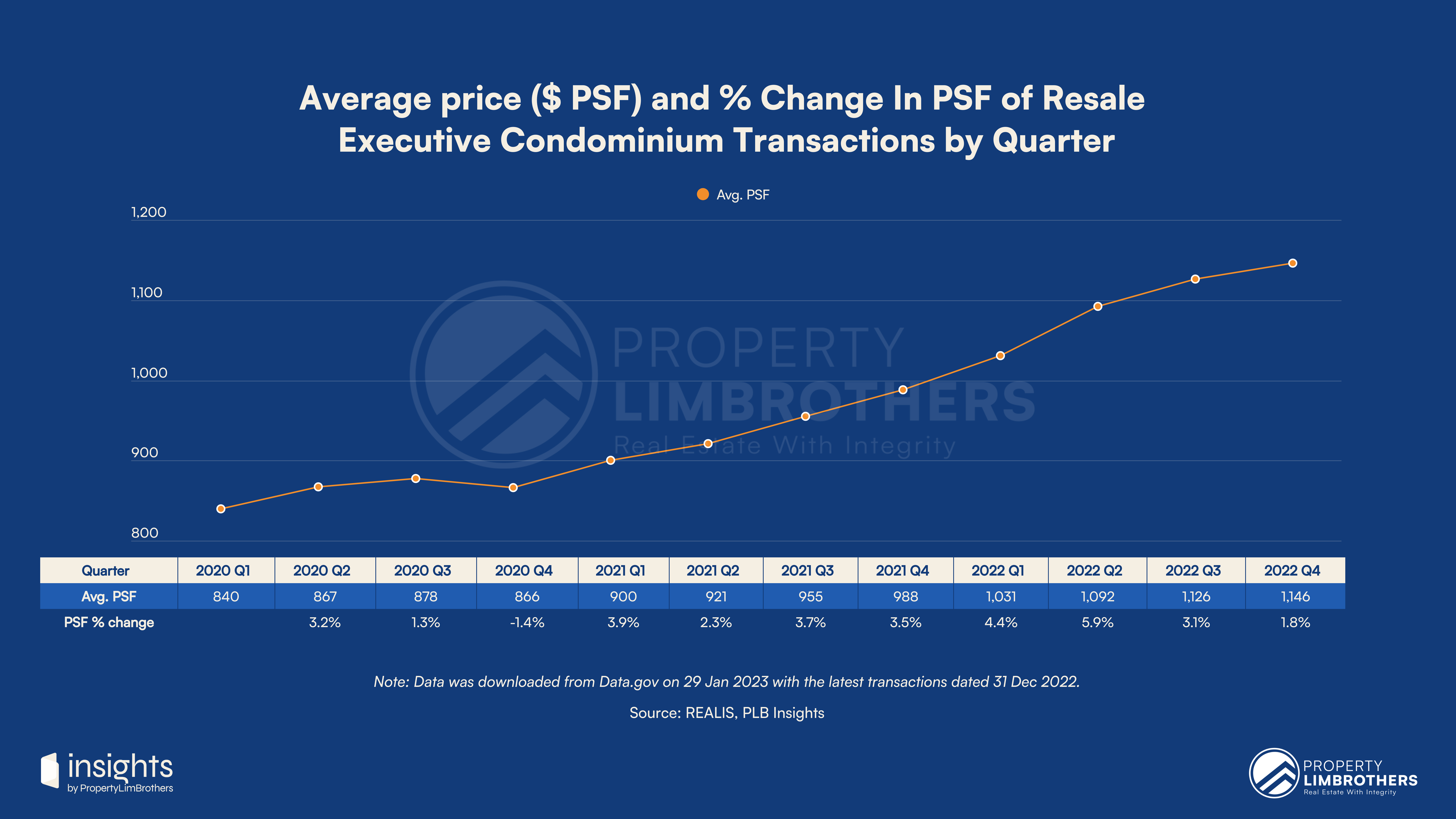
Focusing on the geographical distribution of growth in the EC segment, we notice that Districts 27 (Sembawang, Yishun), 19 (Hougang, Punggol, Sengkang), and 28 (Seletar, Yio Chu Kang) displayed the highest increase in absolute average psf in 2022Q4. These are typically residential clusters and signal strong growth in the heartlands. New sale changes in average psf might not be as reflective of the entire market due to the difference in both launch timing and location across the quarters.
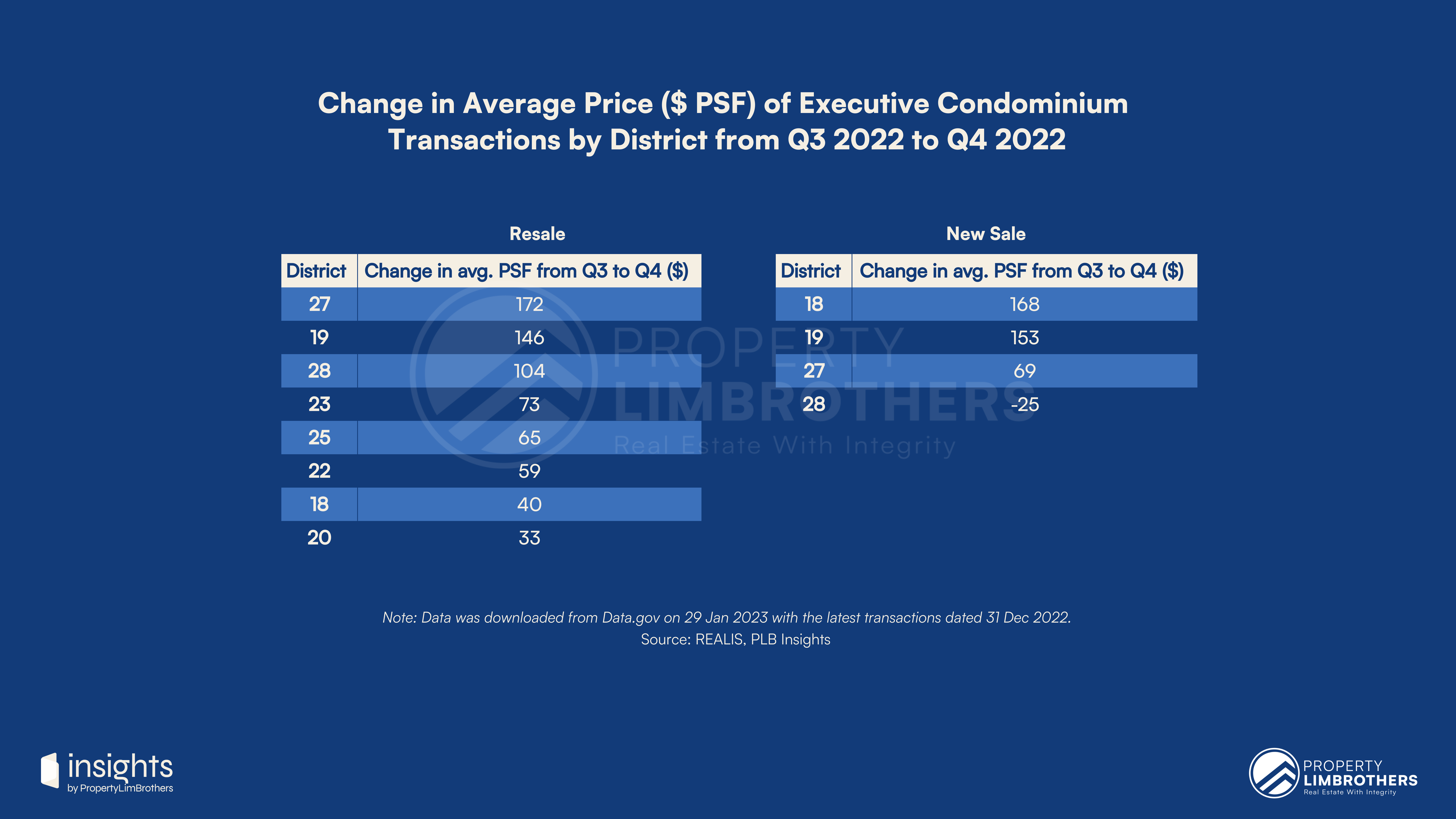
Resale ECs look to experience stronger price performance in the north and northeast regions of Singapore. We expect this trend to continue, with District 22 (Jurong) potentially joining the ranks of top growth areas for ECs in the coming quarters. District 27 and 19 are important residential heartlands and are still expected to be favoured by Singaporeans who love to stay near their families and stick to the familiarity of the same neighbourhood.
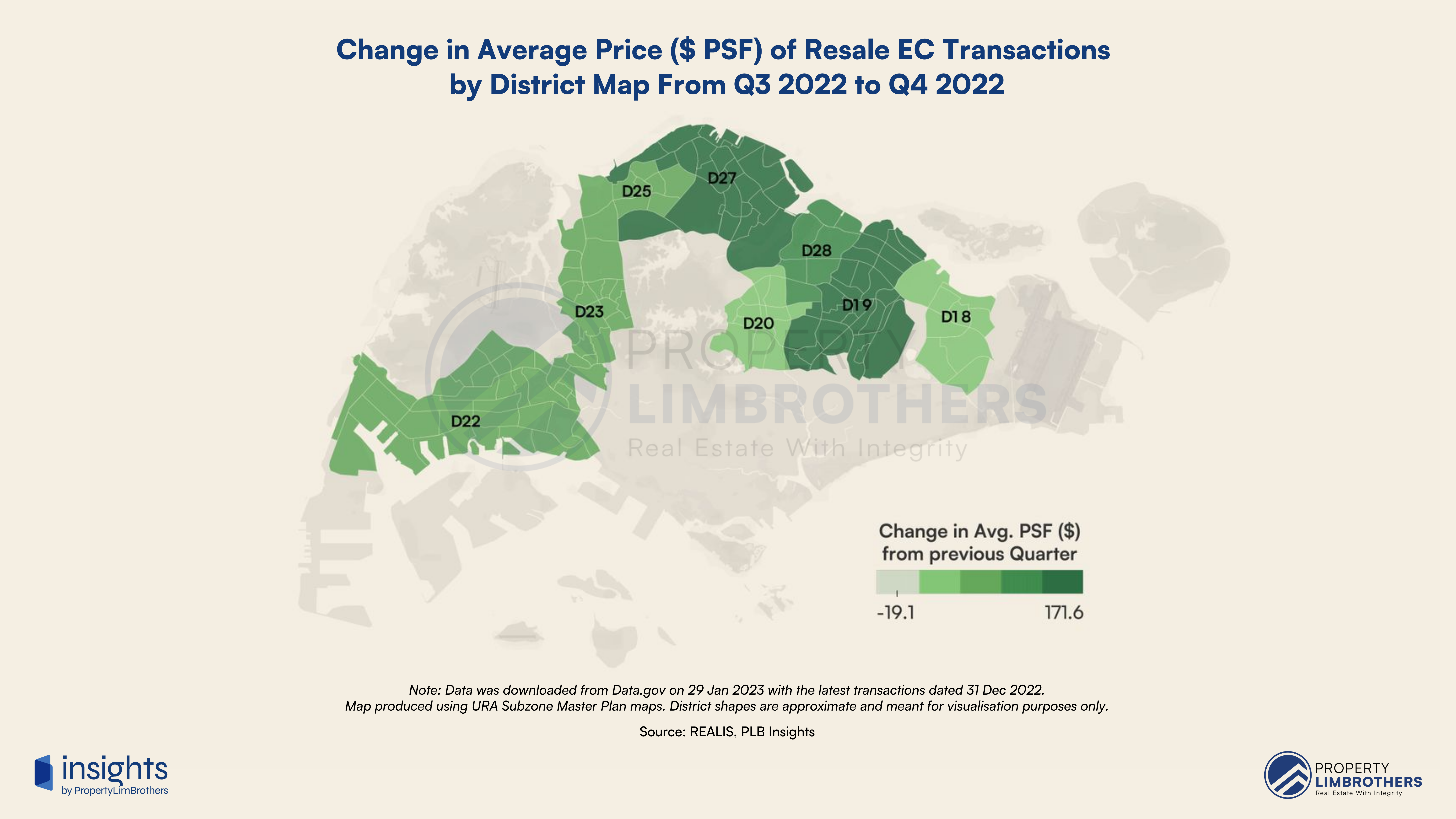
New Sale ECs seem to have the highest psf growth in the northeast region, with District 19 and 18 having the highest gain. The future trends for new sale EC price growth will be harder to pinpoint due to the varying cost factors such as land sale prices. Overall, the price of new sale ECs is expected to increase, but the geographical distribution of this increase still remains unclear.
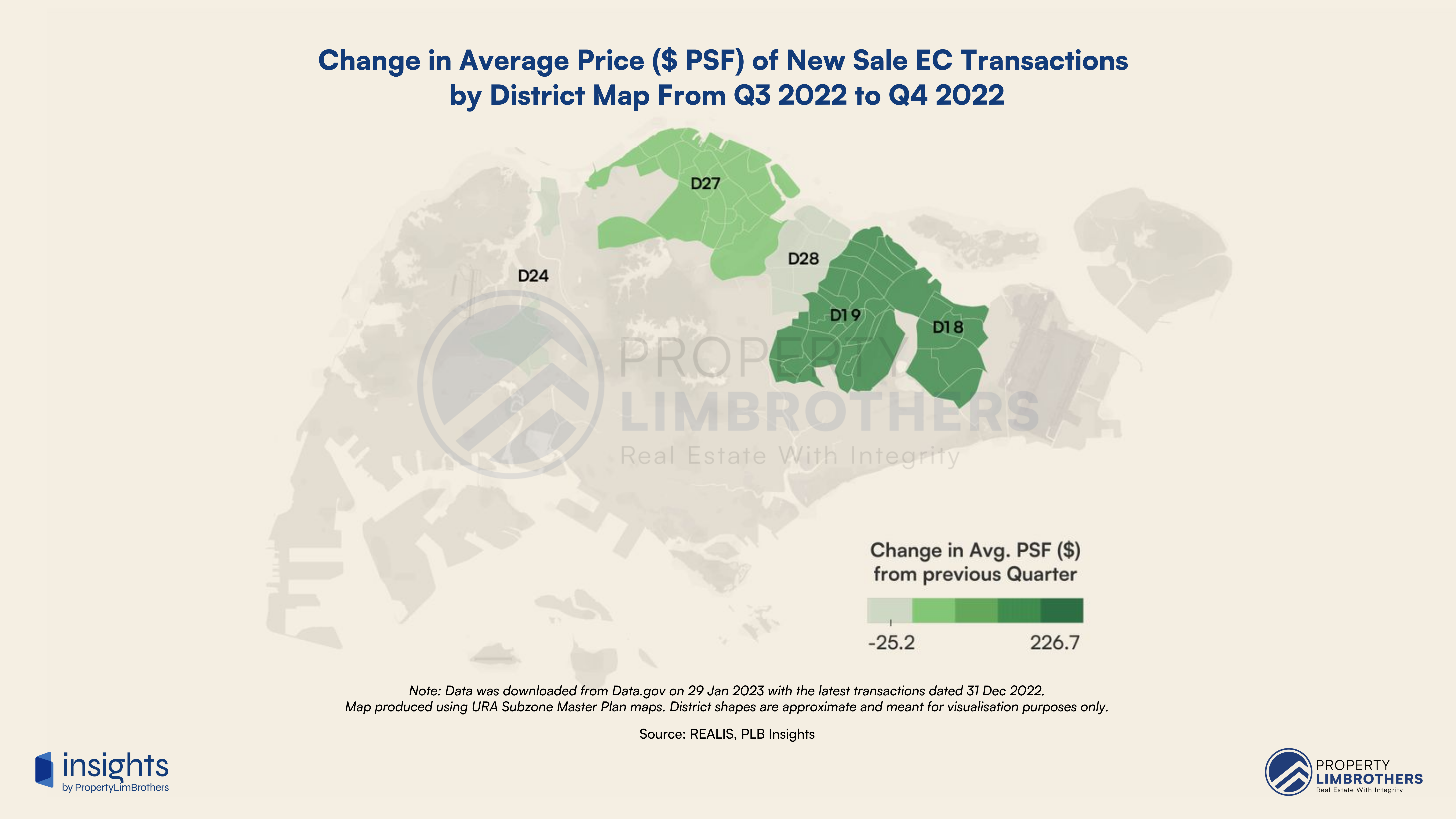
Overall, the Resale and New Sale EC segments will be an attractive and interesting one to watch in 2023. Should property prices rise sharply in the coming quarters, we might see ECs benefitting from the bullish momentum because of their relative affordability to other private properties on the market.
Private Non-Landed Properties Consolidating Pandemic Gains
Private Non-Landed properties (hereafter, Condos) are an important mass market component of Singapore’s private real estate market. The pandemic has seen a steady flow of gains for this property segment. With tougher macroeconomic conditions and cooling measures, we are expecting prices to start stabilising and digesting the gains made over the past 3 years. Volume is expected to continue contracting in the short-term, likely reaching pre-pandemic levels.
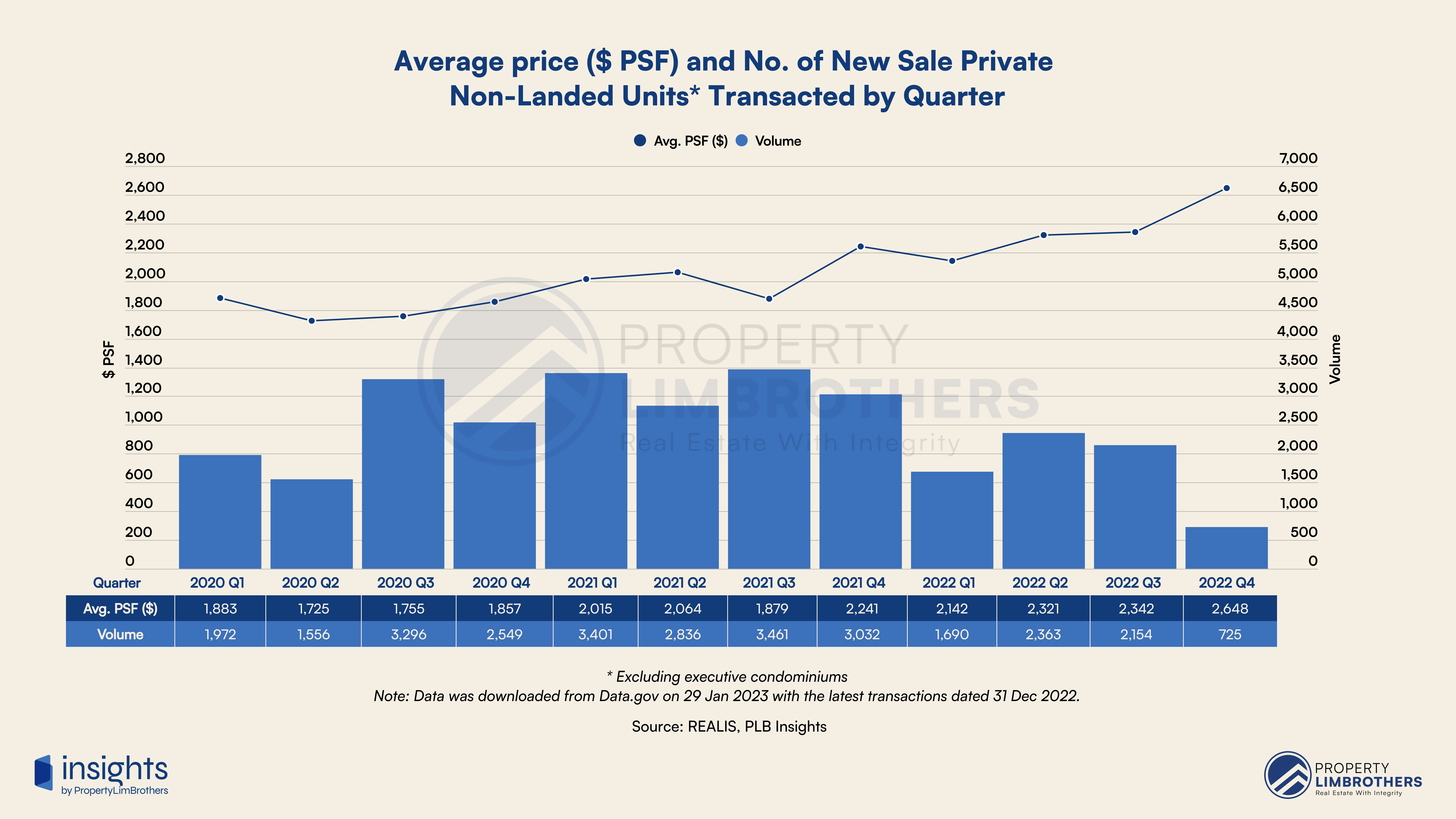
New launch prices have made a new high in 2022Q4. The average price increased from $2,342 psf to $2,648 psf, an increase of 13.1%. This is accompanied by a steep decrease in volume as well. The number of transactions fell from 2,154 in Q3 to 725 in Q4. This is a volume contraction of 66.3%. We do not read too much into this information as it could be simply due to the differences in new launches between quarters. We expect these numbers to fluctuate based on the location of new launches in 2023Q1.

A closer look at the resale transactions of condos will give us a clearer picture of the state of the private property market. The increase in prices has been moving at a steady pace. The average price increased from $1,548 psf to $1,571 psf, an increase of 1.5%. However, the trend in the volume of transactions has not mirrored this steady increase.

As prices increased from 2020Q3 to 2021Q3, volume of transactions has grown in tandem. The number of transactions fell from 3,194 in Q3 to 2,293 in Q4. This is a volume contraction of 28.2%. Since the end of 2021, we are seeing a generic decline or downward trend in the volume of transactions. This could be a reversion to pre-pandemic volumes. If so, we expect volume to continue to decrease in 2023.
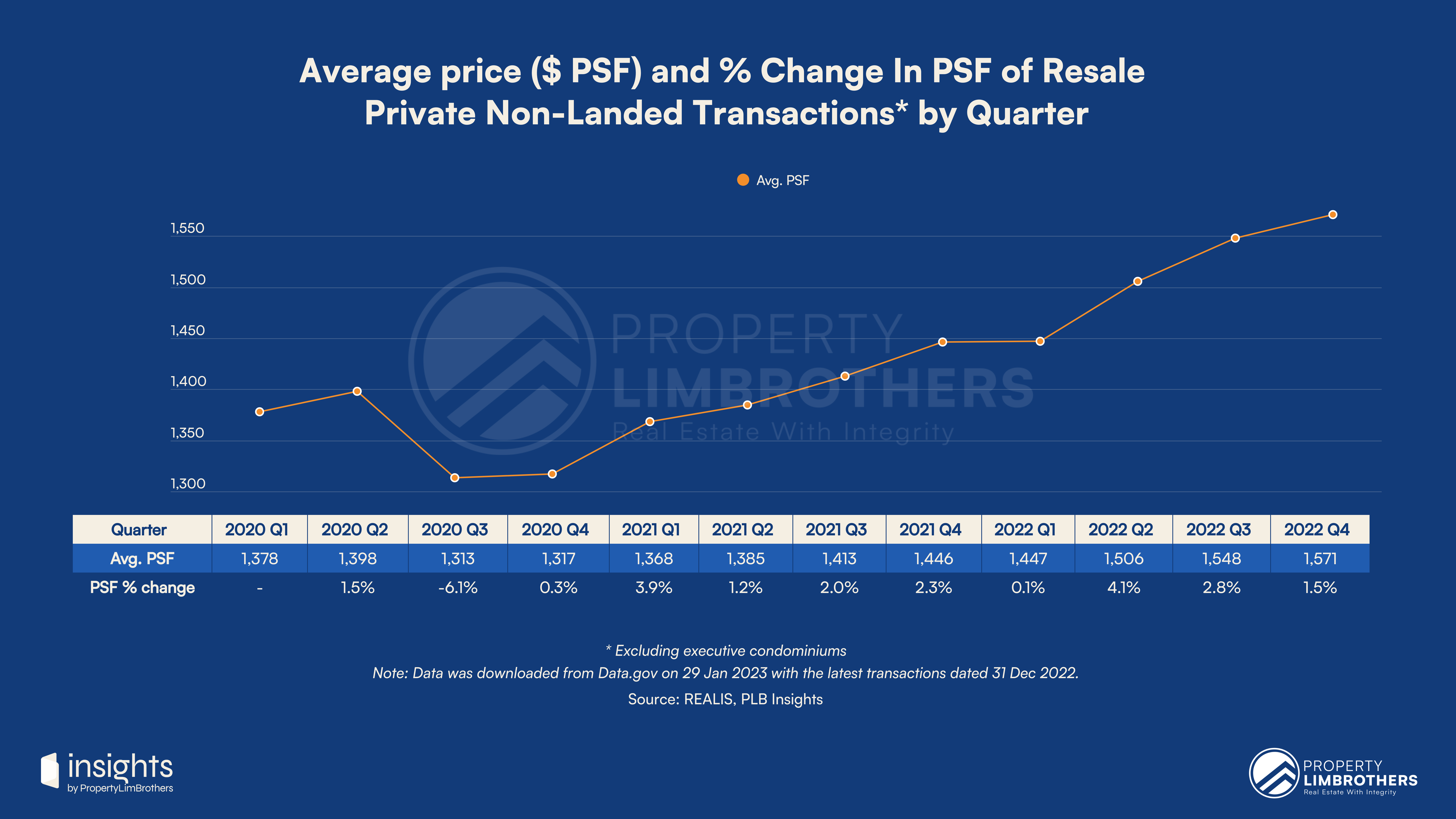
In contrast to the decline in transaction volume, prices of Resale Condos might continue to increase, albeit at a slower rate. The growth in Resale Condo prices seems to be tapering off. However, supply-side issues will be a strong factor in keeping prices elevated across the board. We also expect the performance to vary significantly across different districts.
Districts 2, 7, 10, 4 have performed very well for resale condos, this reaffirms the higher price levels in some CCR and RCR areas. Overall, OCR Districts 21, 16, 18, 27 have also displayed solid and consistent growth over the past few quarters. District 9 in the CCR (Orchard, Somerset, River Valley) experienced the largest fall in average psf.
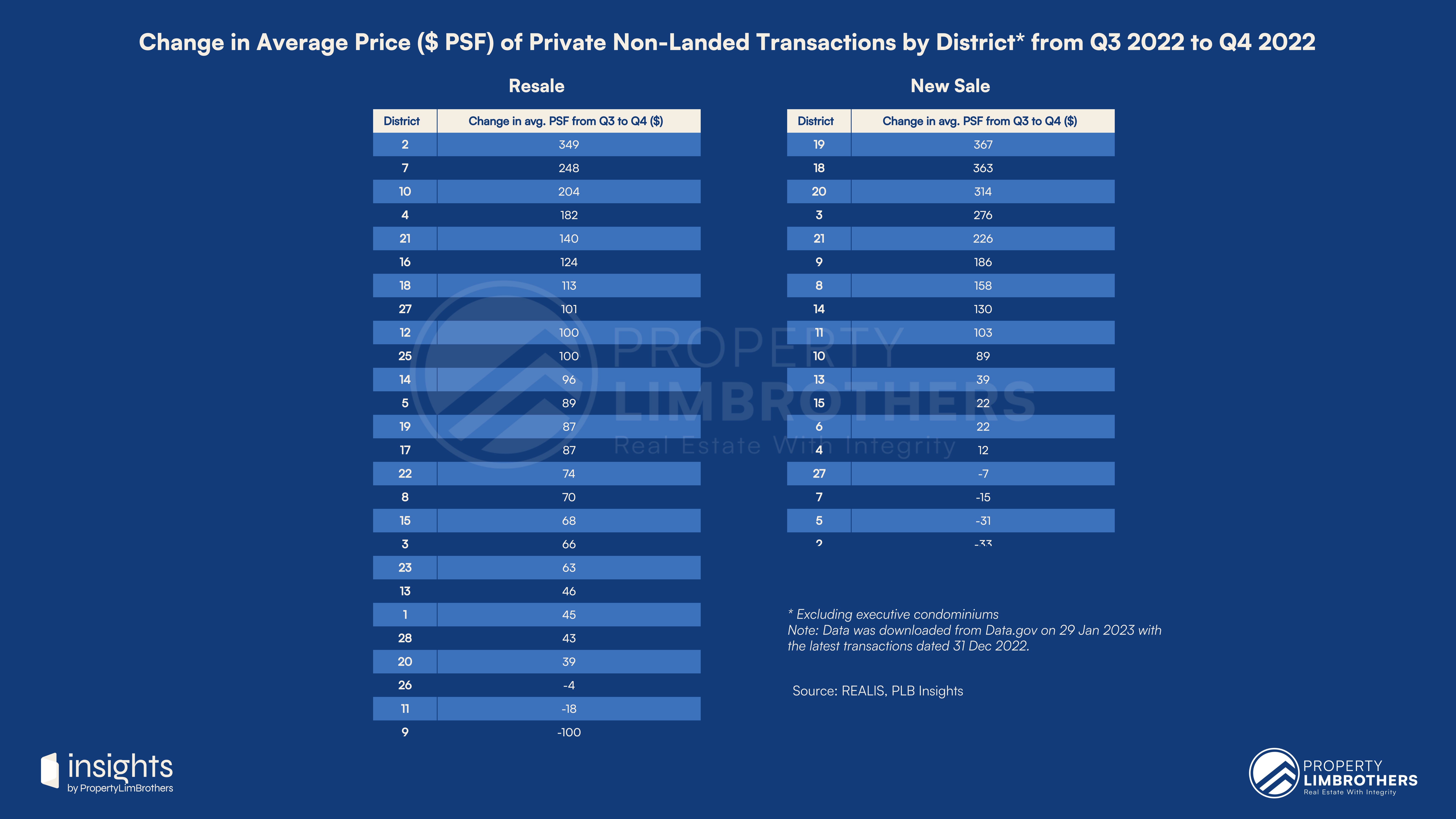
The geographical distribution of absolute average psf increases for new sale condos are slightly different, Districts 19, 18, 20 experienced the highest increase. Whereas CCR Districts 2, 5, 7 experienced some mild decline. This change in new sale prices in the OCR and city fringe areas reflects higher prices developers have been setting for new launch sales.
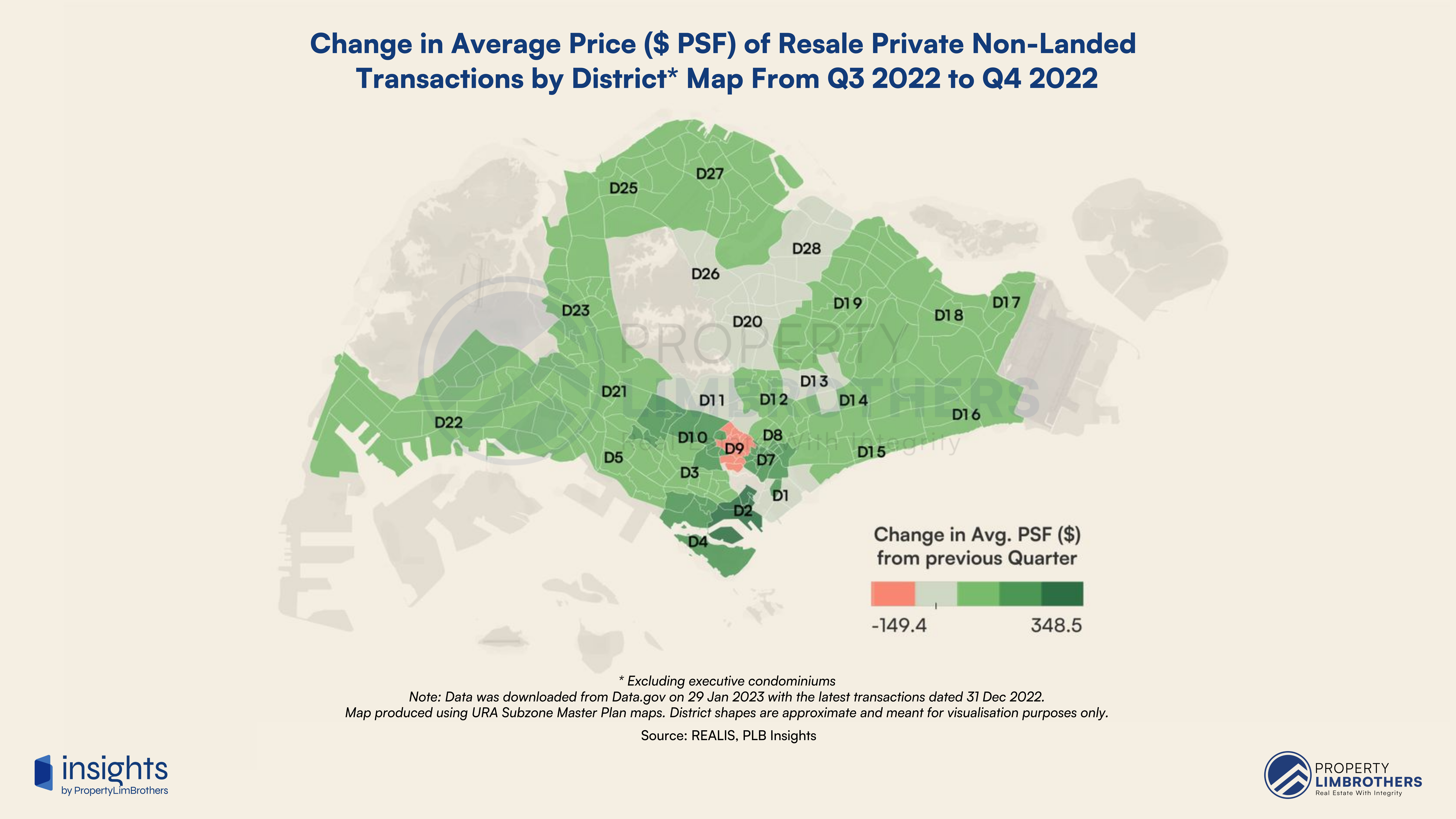
The OCR resale condo prices have been consistently increasing over the past few quarters. This stable growth is largely driven by inflationary pressures and comparatively higher prices in the new sale condo subsegment. The disparity gap between resale and new launch prices will continue to push resale prices up, rather than pull new launch prices down. This is because of the rising costs developers face in land sales, construction, and business expenses. The CCR region continues to experience volatility as discussed in previous reports.
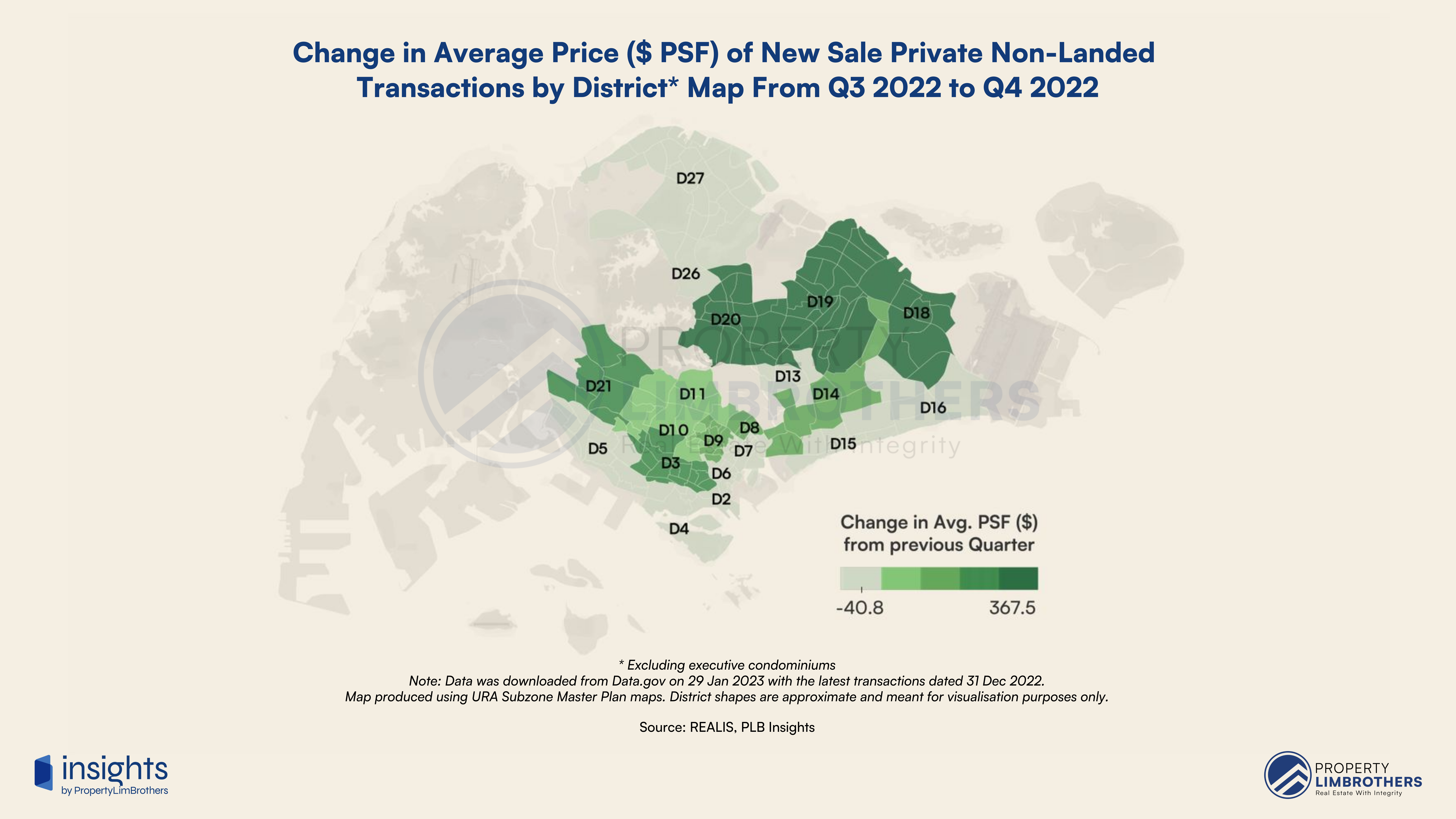
The new sale condo subsegment experienced the greatest increase in absolute average psf in the Bishan-Ang Mo Kio area in District 20, stretching east to the Pasir Ris-Tampines area in District 18. District 19 which holds Punggol, Sengkang, Hougang estates also experienced a strong increase in absolute average psf. These numbers should be taken lightly due to the lower volume of transactions in Q4. The larger changes in absolute average psf might be due to the much smaller sample of new sales. We expect new sales for condos to pick up in volume for 2023 as new projects hit the market after the revenge travelling season of 2022Q4.
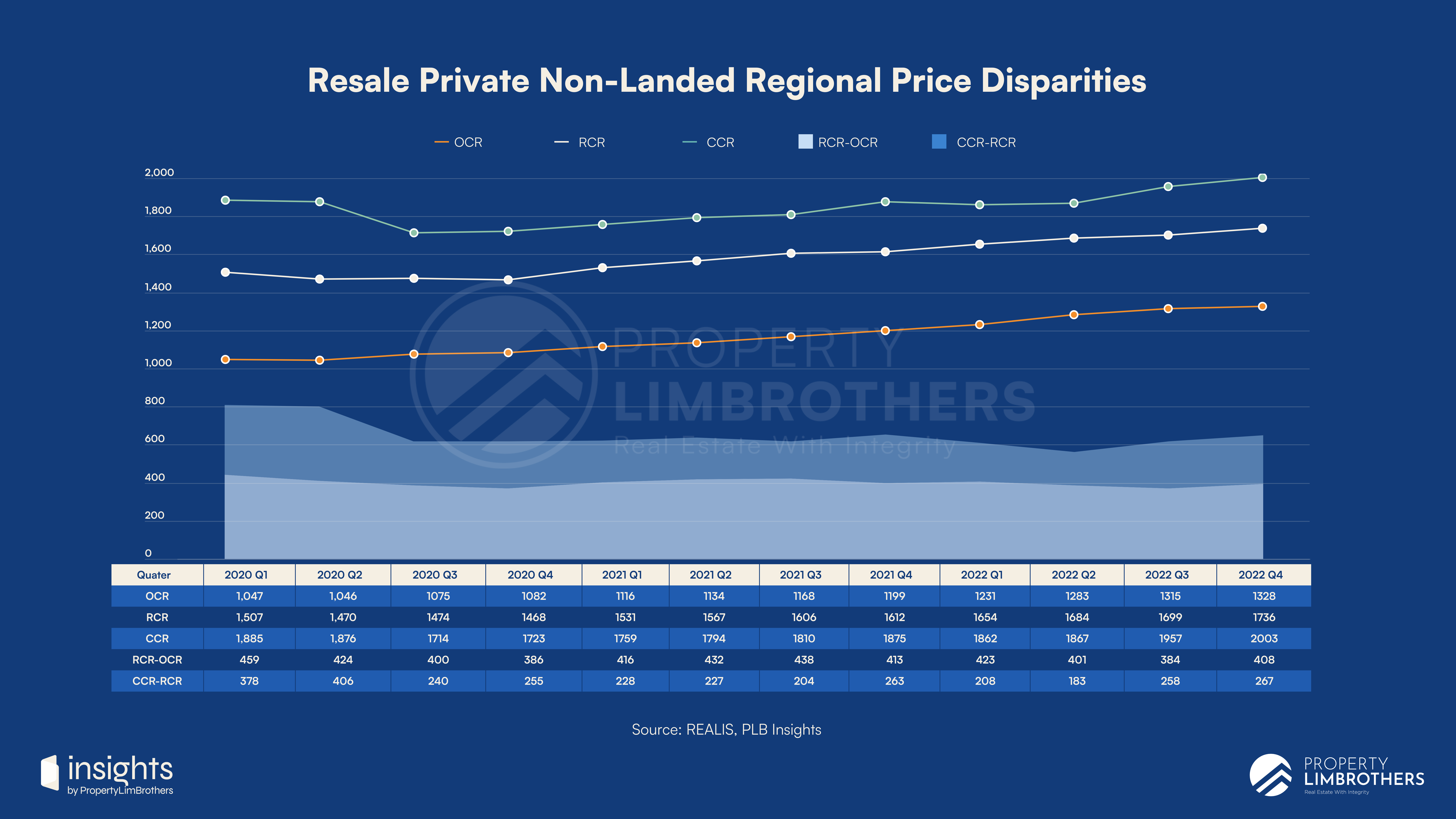
When we observe the price disparity between the different regions, we notice an upward trend for all regions. The disparity gap seems to have widened in 2022Q4, with the RCR-OCR gap increasing by 6.1% and the CCR-RCR gap increasing by 3.8%. This disparity gap reveals that city fringe resale condos have been growing more relative to other regions. We expect the disparity gap to close as transaction volume in the market cools. However, there is still the possibility that volatility in transactions could add noise and widen the disparity gap in the coming quarters.

The new sale condos have a very different price disparity profile. We see that new launches in the CCR and RCR have a much narrower price difference compared to the resale condos. This might be due to a supply difference between new sale condos in the CCR and the number of resale options available in the CCR. The RCR-OCR gap increased by 8.3% and the CCR-RCR gap increased by 8.6%. This indicates that the CCR and RCR price increases for new launches are outpacing that of the OCR options.
Overall, OCR resale condominiums are still the safest choice when it comes to affordability and potential for appreciation. While RCR and CCR options have displayed decent growth in 2022Q4, the price point and disparity gap might be difficult to maintain over time. We expect OCR resale prices to catch up over the course of the coming quarters.
Landed Properties Inch Higher Despite Slowdown
The Landed segment is a good forward indicator of investor sentiment in the real estate market. At higher quantums, the “smart money” of the real estate industry indicates where the market might be headed in the near future. We have covered this in earlier reports and will continue to interpret the Landed segment in this manner. The Landed segment has relatively smaller volume with much higher quantums, making this segment more sensitive to macroeconomic changes in the larger financial sector such as the interest rate environment and inflationary conditions.
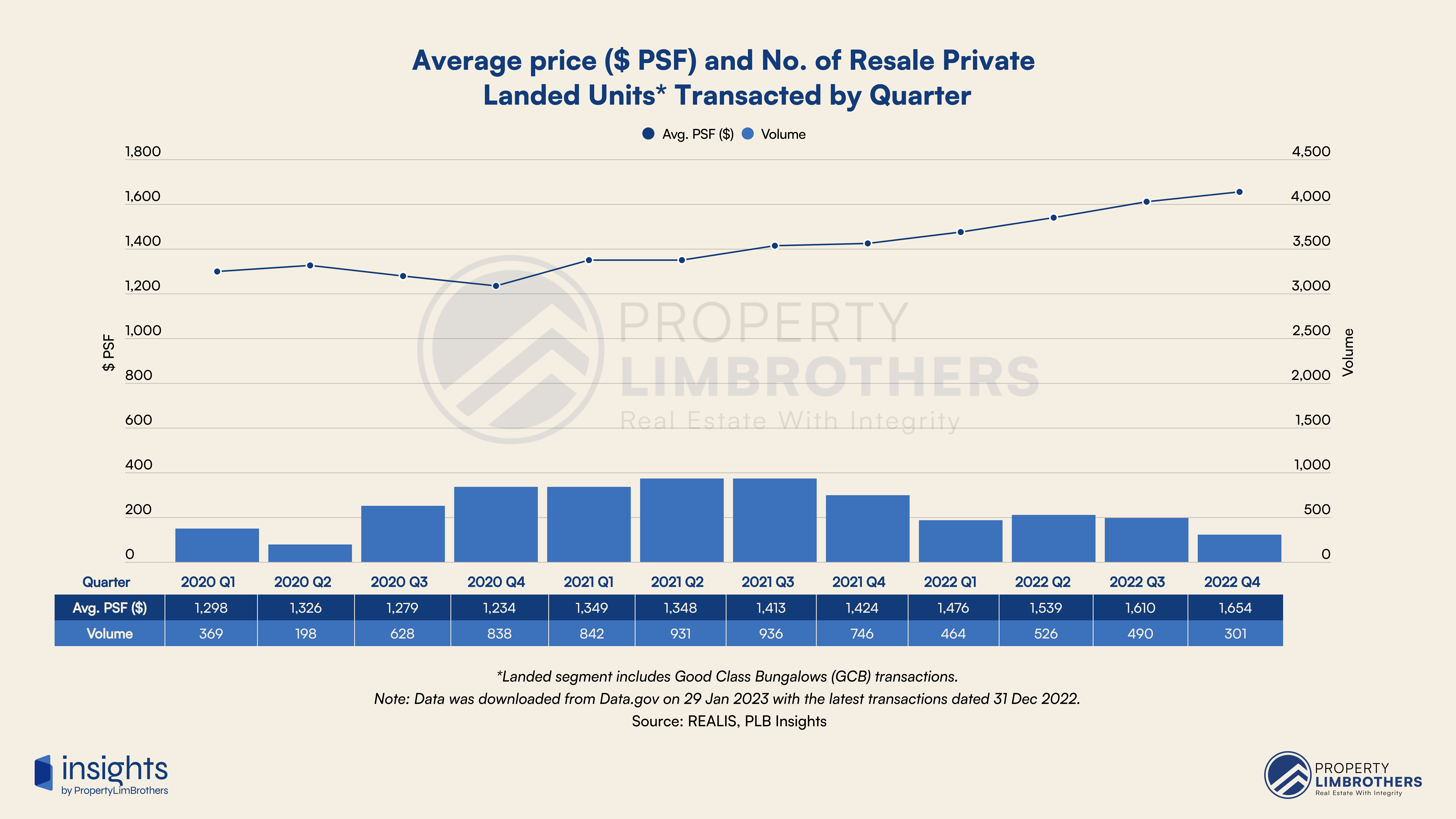
For resale transactions in the Landed segment (Detached, Semi-Detached, Terrace, Good Class Bungalows), we see a rise in average psf from $1,610 to $1,654 psf. This is a 2.7% increase in price. However, we see a fall in volume from 490 transactions in 2022Q3 to 301 in 2022Q4, contracting by 38.6%. This indicates a smaller increase in price and a larger decrease in transaction volume as compared to the previous quarter. This indicates cautious optimism and supply-side constraints as higher prices are still being accepted by the market albeit at lower quantities.
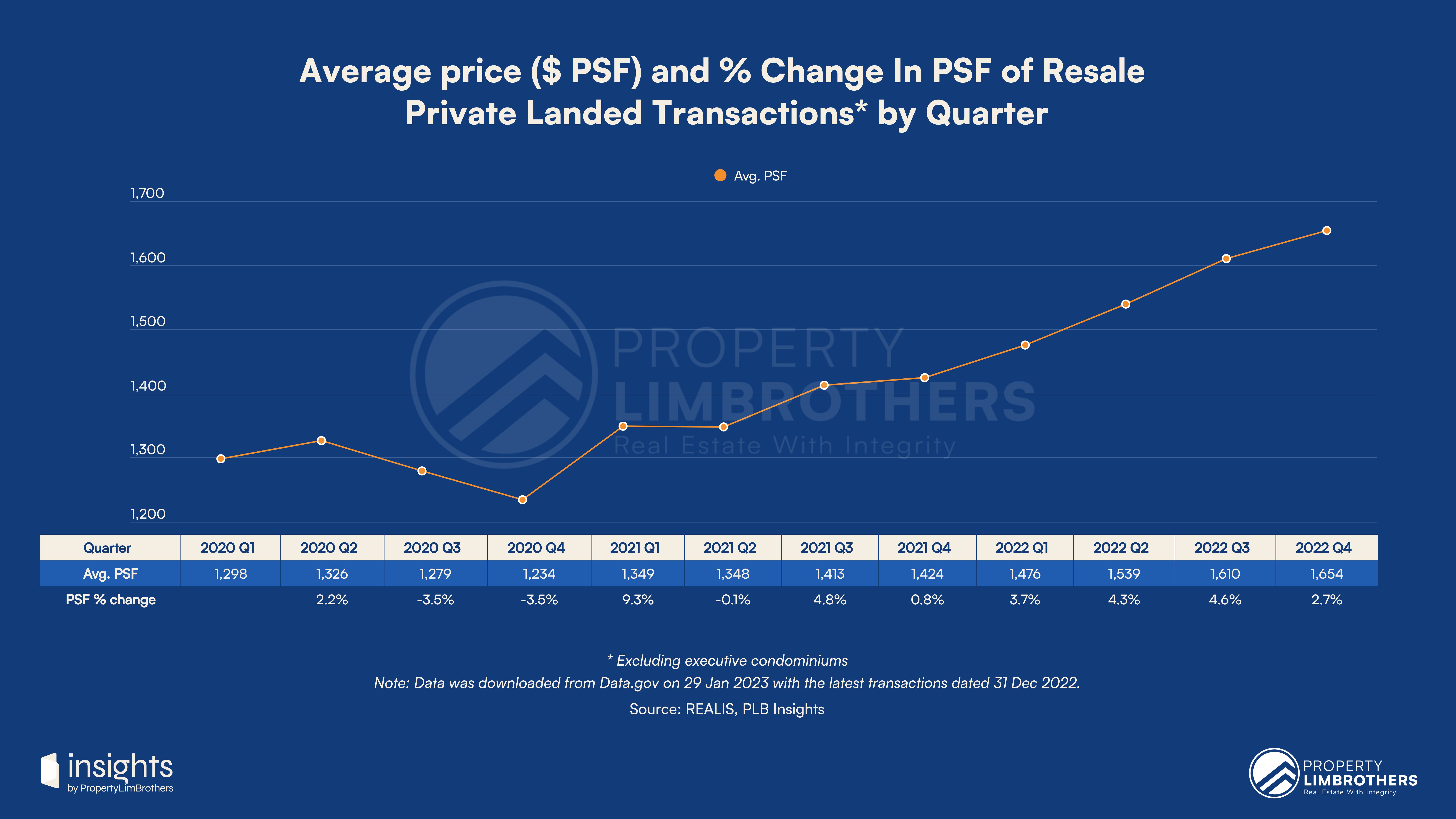
The average psf of resale Landed properties have been on a strong uptrend from the end of 2020 to present. There were quarters of price consolidation in 2021Q2 and 2021Q4. We might have such consolidation behaviour in the Landed segment in 2023 as the market takes time to digest the higher price levels. However, as the Landed segment is sensitive to macro shifts, any surprise interest rate hikes or cuts could affect the price movement to some extent. Weak economic performance in the first two quarters of 2023 can also hurt the price growth of the Landed segment.
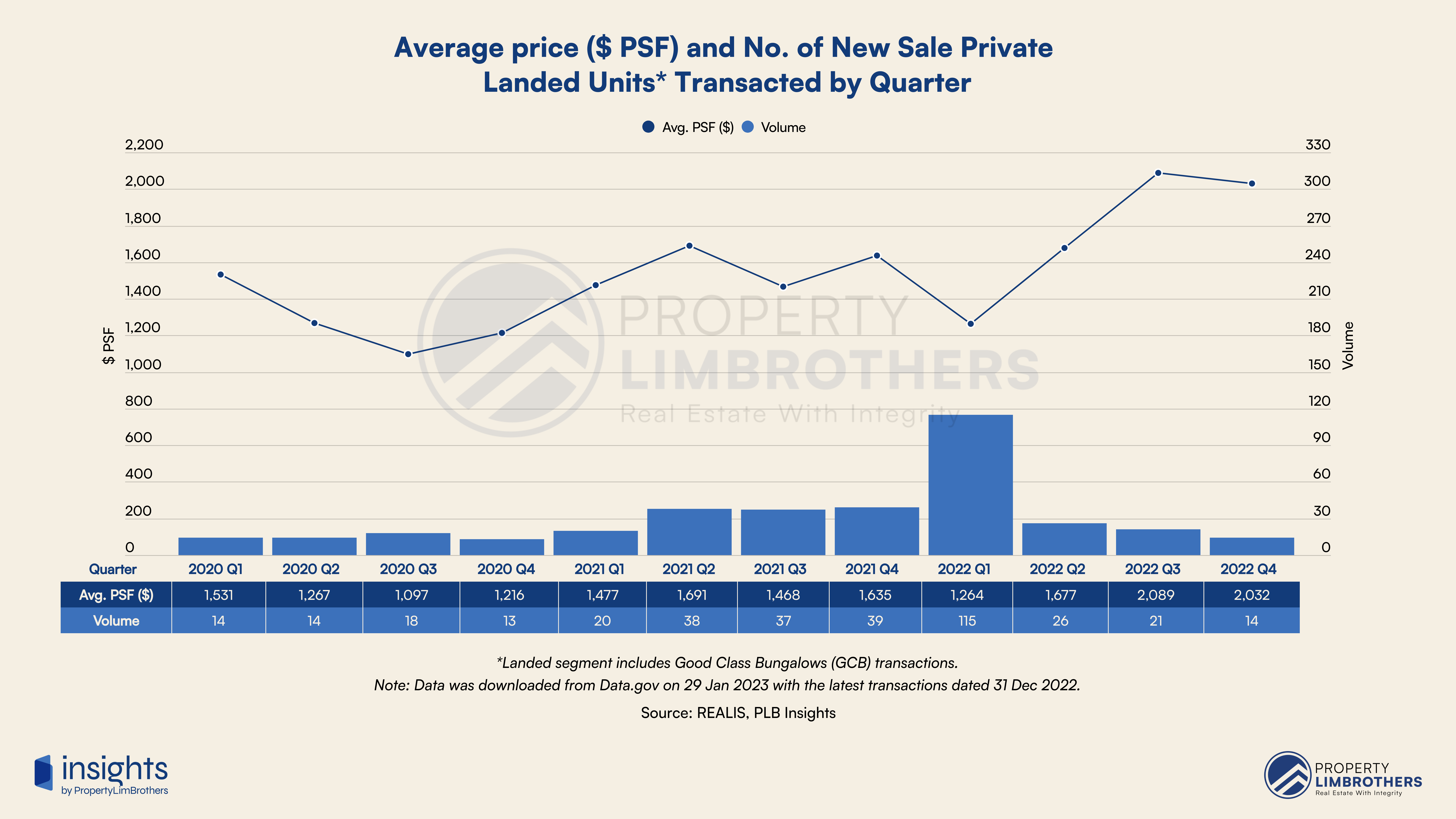
On the flipside, we see that new sale Landed properties have declined in price for 2022Q4. The average psf decreased from $2,089 psf in 2022Q3 to $2,032 psf in 2022Q4. This is a 2.7% decline from the previous quarter. Do note that new sales Landed is not representative of the entire landed segment due to the small sample size. There were only 14 Landed new sale transactions in 2022Q4. This represents a decline of 33.3% in transaction volume, from 21 transactions in 2022Q3. Due to this small sample nature, we observe a much higher volatility and inconsistent price movement.
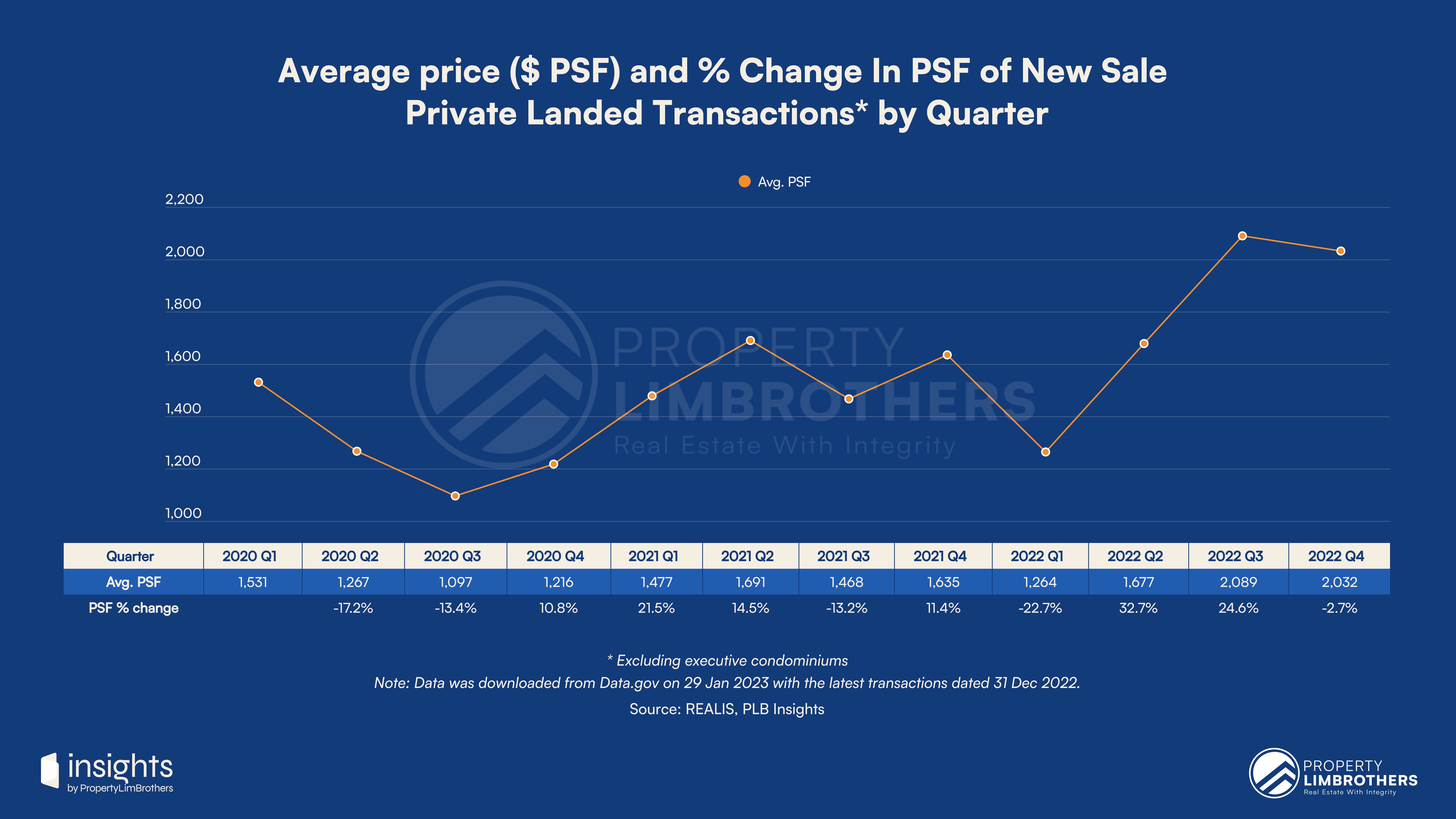
Taking a closer look at the geographical distribution of changes for resale Landed properties, we notice that Districts 13 (Potong Pasir, Bidadari, MacPherson, Upper Aljunied), 26 (Lentor, Mandai) and 10 (Tanglin, Bukit Timah, Holland) have the top increase in absolute average psf whereas District 9 (Orchard, Somerset, River Valley) experiences a high magnitude drop in absolute average psf.
Interestingly, District 9 experienced poor performance overall in the private property market. This could be a sign that the market is rejecting exorbitant prices for the orchard area and the preference for centrally located properties is more broadly defined.
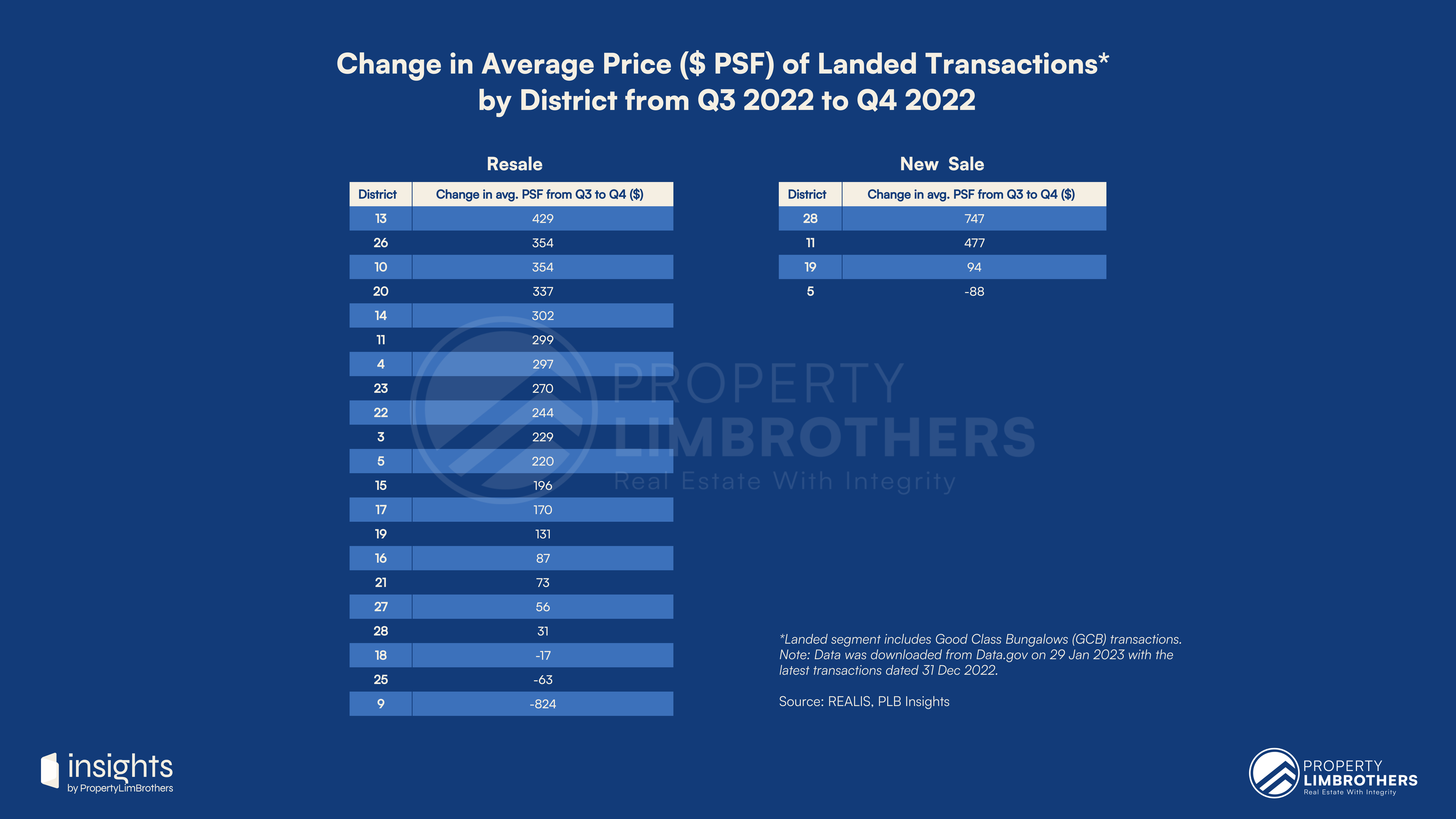
As mentioned earlier, the smaller sample of new sale Landed properties makes that subsegment particularly volatile, and is not a reliable indicator of the segment at large. Thus, market participants should pay more attention to the resale transactions in the Landed market instead.
The city fringe area sees higher increases in absolute average psf for the resale Landed properties. However, some OCR districts that have previously performed well in the resale Condo segment do not see the same performance in the resale Landed segment. District 25, 27, 28, 19, and 18 showed stable prices in 2022Q4 for resale Landed properties.
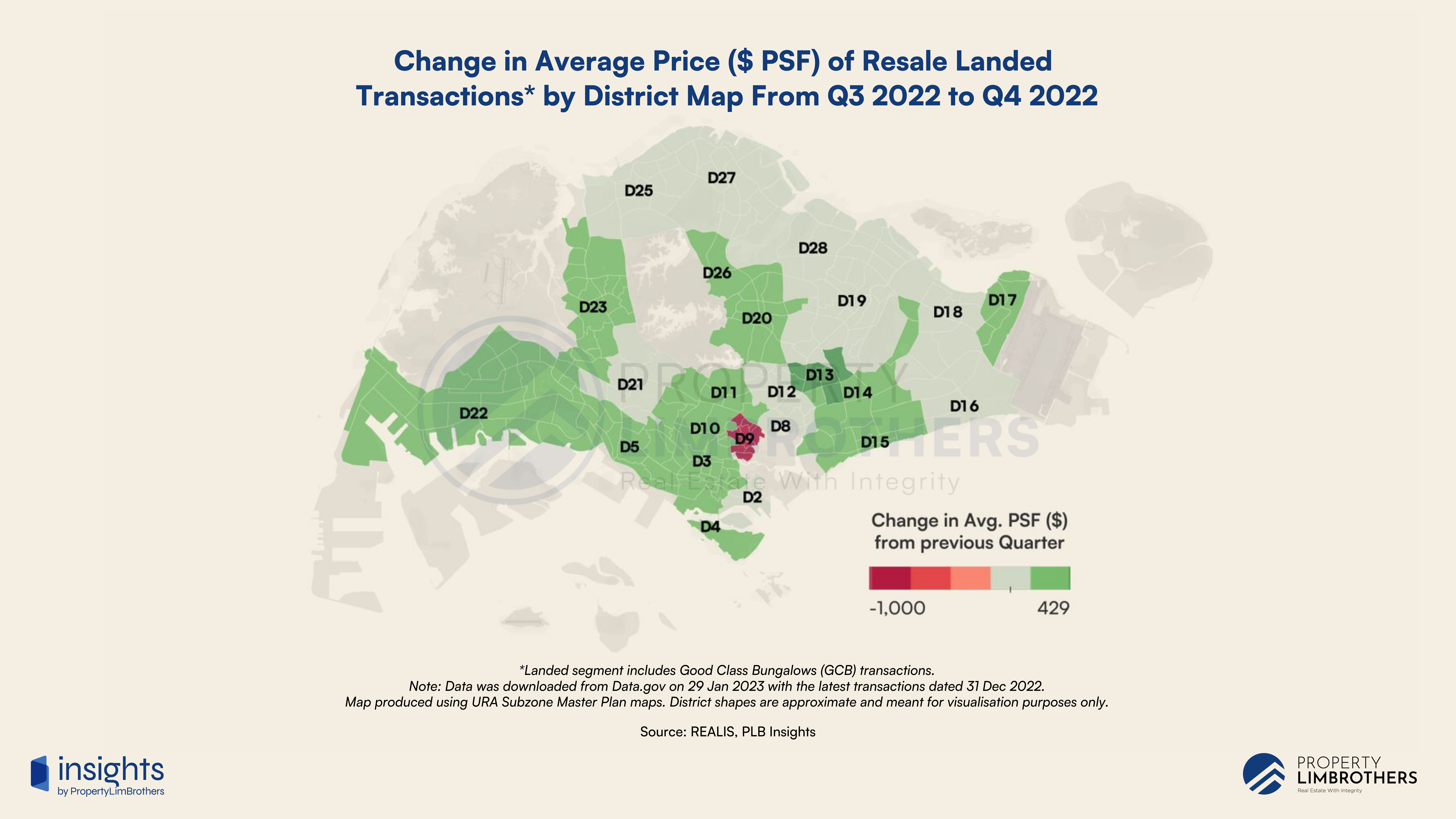
We interpret this difference in performance for OCR districts in the Landed segment as a matter of consumer preference. Being a different demographic, Landed home buyers seem to put a larger emphasis on city fringe living as opposed to non-landed home buyers. Given that Landed properties are of a much higher quantum, Landed home buyers might be more willing to top up for a more centrally located home in the city fringes.
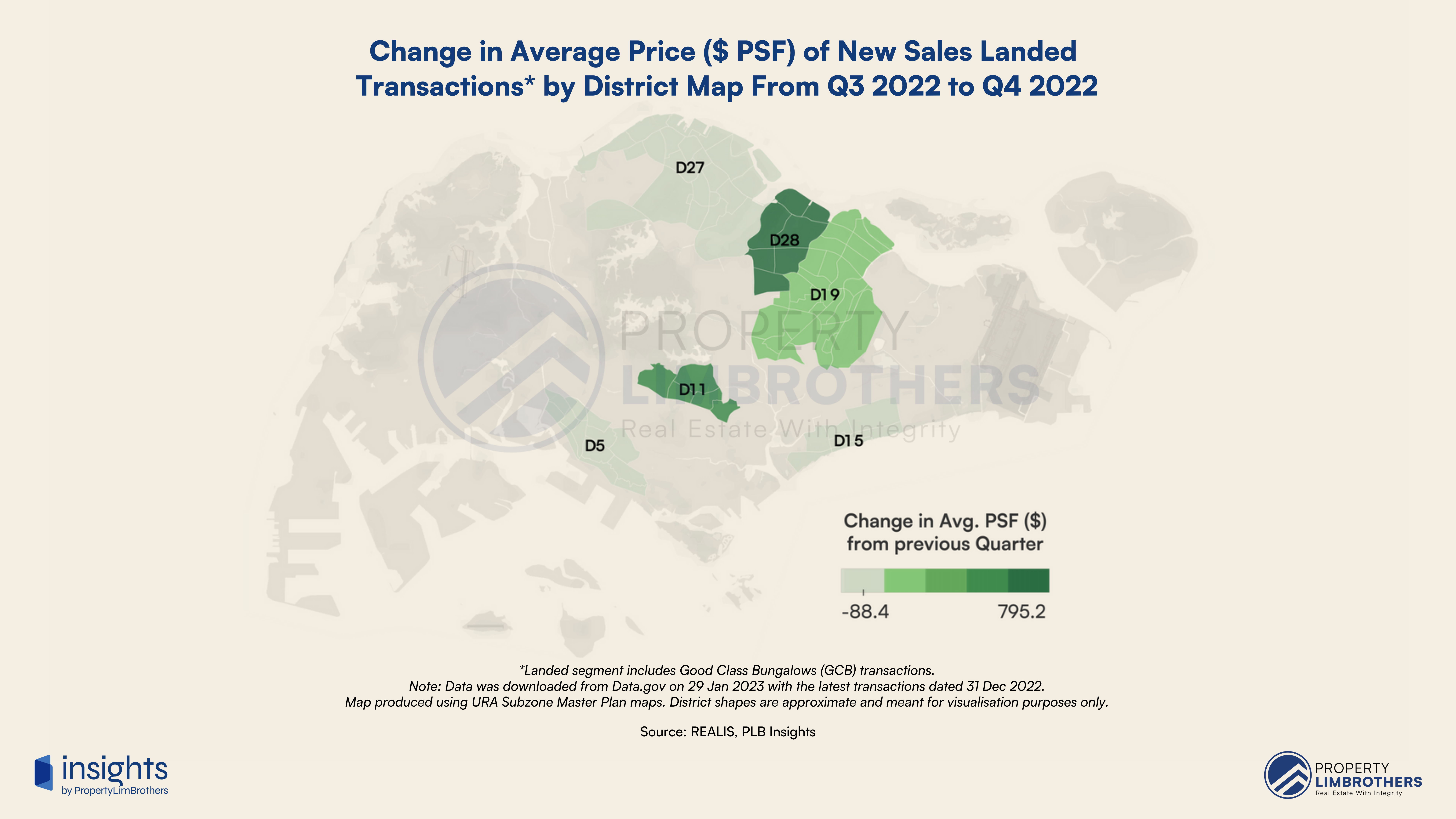
Curiously, the new sales for the Landed segment sees the highest increase in absolute average psf in District 28 in the OCR. While this does not represent the larger market or consumer preference at large, we still see the occasional new sale transactions in the OCR that sets higher psf levels
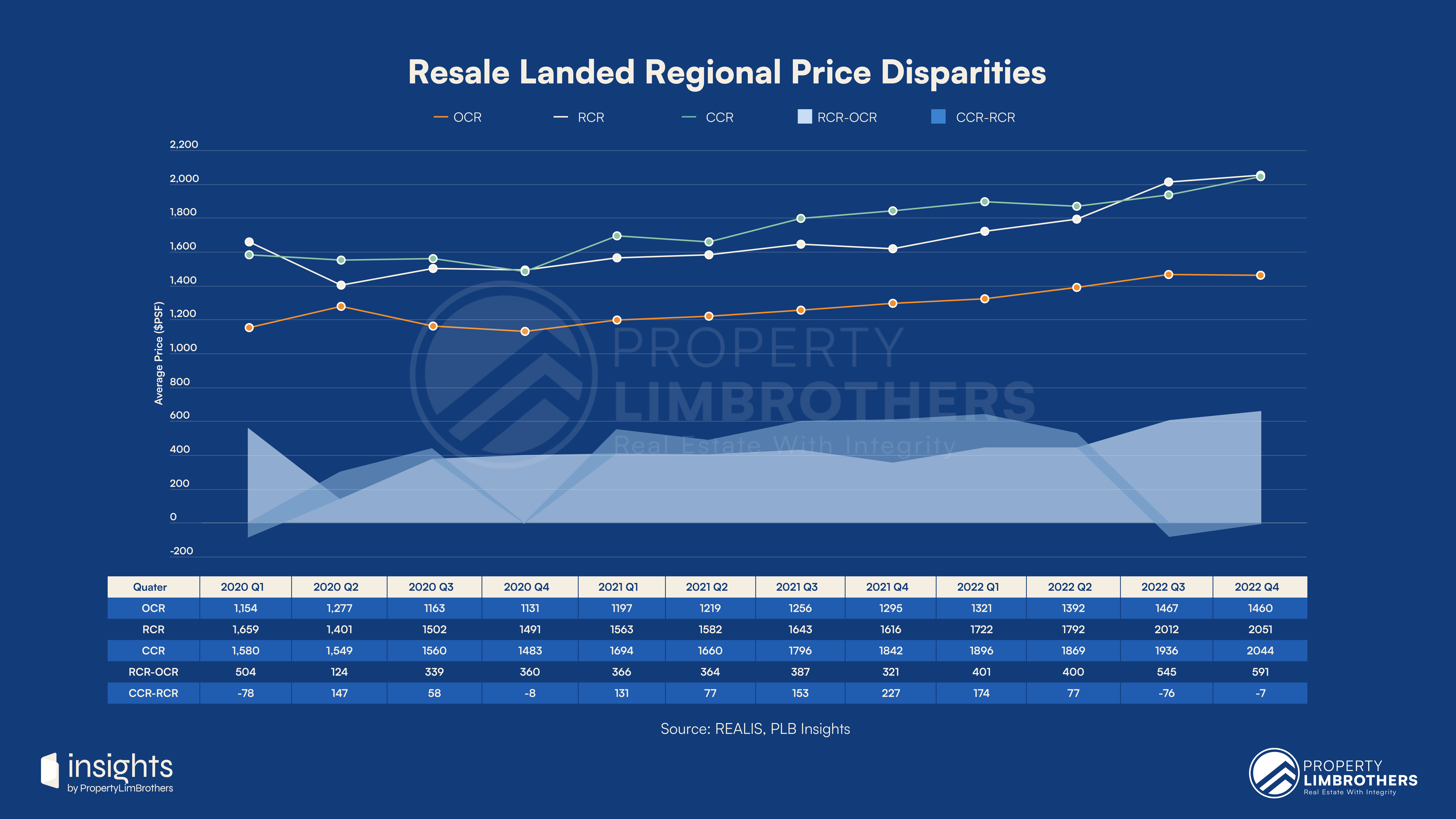
Focusing on the price disparities between regions for the resale Landed segment, the gaps between the RCR and CCR are even more narrow than for new sale condominiums. Previously in the Landed segment, the preference for the city fringes seemed to have trumped that for the city centre in Q3. While the disparity gap inversion for CCR-RCR properties is held in Q4, the gap is much narrower. Market preference for CCR and RCR Landed properties seem to be at a matched level. On the other hand, the RCR-OCR price gap has widened by 8.4%, driven by a mild decrease of 0.5% in the average psf for OCR Landed properties and an increase of 1.9% in the average psf for RCR Landed properties.
In the Landed segment, we expect the resale disparity gap to widen. With tougher macroeconomic conditions, we expect the market to be increasingly fragmented. Transactions will continue to slow down, with more top-end Landed properties being transacted and entry-level OCR landed properties moving in the market. The disparity gap could continue to widen as a result of the added volatility.
Overall, the Landed property segment is a must-watch for avid property market enthusiasts and investors. Those who are planning to enter the market in 2023 can use this segment as an forward indicator of market sentiment coupled with an in-depth analysis of the property class of interest. We expect stable growth for the prices of city fringe Landed properties.
In Focus — Opportunity Spaces for 2023Q1 and Beyond
This final section of the report highlights opportunity spaces to keep our eyes on as global macroeconomic conditions continue to unfold. In the Q4 report, we highlight opportunities in every residential property segment so that our readers across different backgrounds can benefit from the insights generated.
In the HDB segment, we expect OCR HDBs to have the most consistent growth rates over the coming quarters. While this segment at large is expected to be the most resilient in terms of price and volume, more expensive HDB estates (such as Clementi) will have limited upside potential. This remains the same opportunity space we have highlighted in the previous reports with an added caveat on more expensive mature HDB estates.
In the EC segment, we expect the North and Northeast regions to continue its strong growth trend for prices. The volume is expected to be resilient. Despite strong performance quarter after quarter we believe ECs in these regions have room for further upside due to the price disparity that still exists with private non-landed alternatives. This is the same opportunity space we have highlighted in earlier reports.
In the Private Non-Landed segment, OCR Resale Condos still remain as the core opportunity space as it puts out consistent growth performance across most districts. This remains the same opportunity space as we had put forth in earlier reports. However, we expect ECs to gain more traction over the next few quarters. Volume in the private non-landed segment may experience further slowdown.
In the Landed segment, city fringe properties remain as a market favourite for this home buyer demographic. The RCR-OCR disparity gap widened in Q4 and we expect prices and volume to remain volatile in the coming quarters due to the high interest rate environment and tough macroeconomic conditions.
With these opportunity spaces in mind, we look forward to bringing you more relevant and insightful research in our editorial before the Q4 report. Thank you for your support for PLB Realty.
Caveats & Disclaimers
The insights generated from our report are reliant on the data providers we have used in the process of producing this report. The accuracy of this report is reliant on the data integrity of the relevant data providers.
Any information found in this report does not constitute financial or real estate advice. Please do your own due diligence before making any financial commitments to any related investments or property decisions. Consult the relevant professionals to make sure that you have a proper understanding of your financial situation and that the decisions made are to your best interests.
If you wish to get in touch with our real estate experts, you may contact us here. We are more than happy to discuss the contents of this report in-depth, and how it relates to your personal property journey.


